Attributes and Sustainability of a Smart City
VerifiedAdded on 2022/12/27
|25
|5061
|1
AI Summary
This study material explores the attributes and sustainability of a smart city, including the use of technology, challenges, and opportunities. It discusses the importance of information and communication technology, as well as the benefits it brings to various sectors such as government processes, public services, transportation, security, education, and healthcare. The material also highlights the challenges faced in implementing smart city technologies and the potential of smart cities in creating a resilient and sustainable urban environment.
Contribute Materials
Your contribution can guide someone’s learning journey. Share your
documents today.
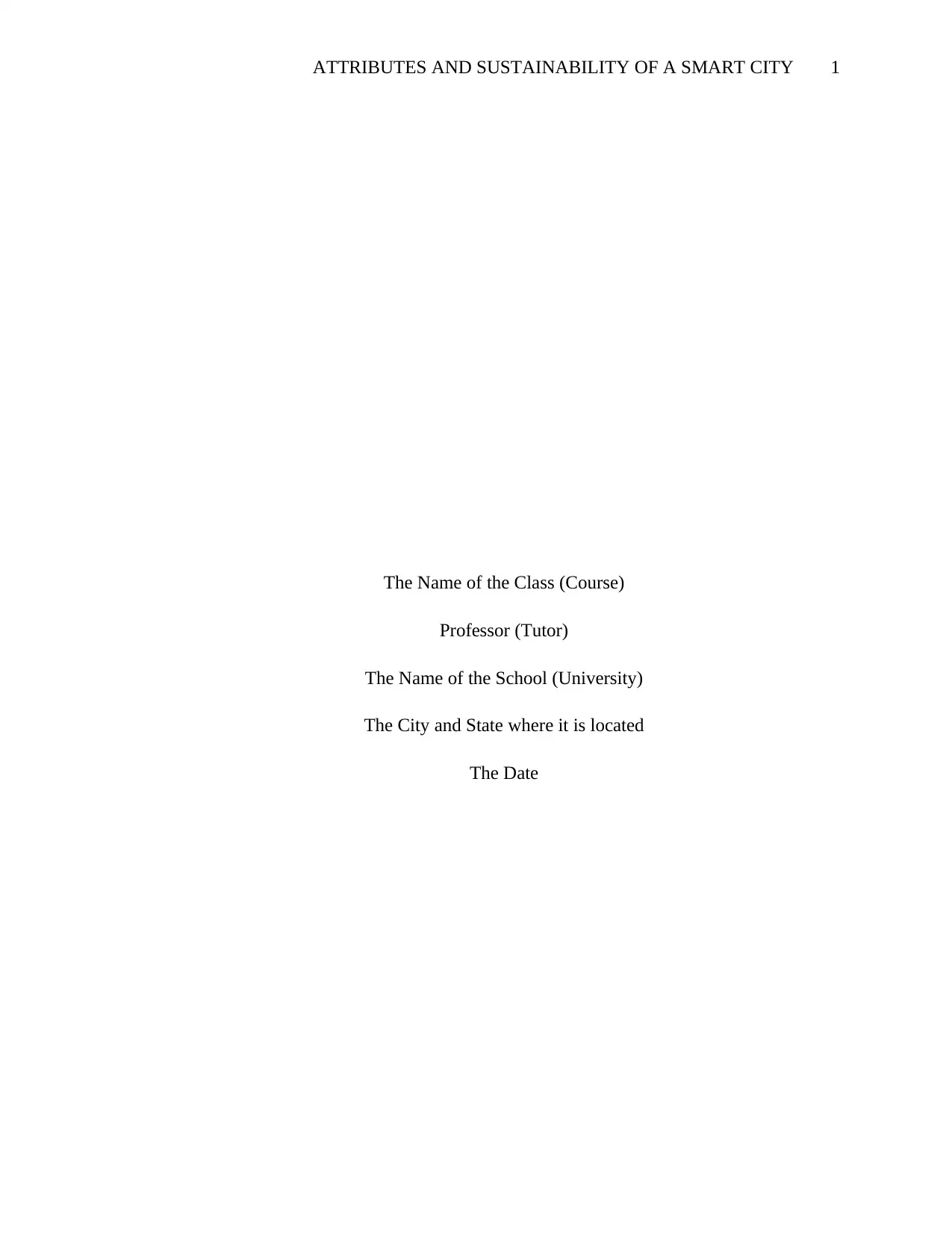
ATTRIBUTES AND SUSTAINABILITY OF A SMART CITY 1
The Name of the Class (Course)
Professor (Tutor)
The Name of the School (University)
The City and State where it is located
The Date
The Name of the Class (Course)
Professor (Tutor)
The Name of the School (University)
The City and State where it is located
The Date
Secure Best Marks with AI Grader
Need help grading? Try our AI Grader for instant feedback on your assignments.

ATTRIBUTES AND SUSTAINABILITY OF A SMART CITY 2
Smart cities are urban areas that use different types of electronic devices, internet of
things (IoT), sensors and they have incorporated information and communication technologies to
collect data and analyze their information in order to enhance and improve their service delivery
in areas such as energy, transportation sector, and utilities. In order to minimize resource
consumption, wastage and the overall cost. (Fang and Yu, 2017, pg.126). Their main objective is
to provide basic infrastructure, give a decent life to its citizens, provide a clean environment,
good health care, waste management crime detection, and clean water through the application of
smart solutions.
Most urban areas are generating different opportunities to develop smarter cities, safer
and greener communities and boost the economy of its citizens. This is achieved through the
attraction of new businesses leading to the creation of new jobs. (Jabareen, 2016, pg.38).They
use mobile data networks and internet of things technology and other innovative applications that
are developed to provide safety, increase production and provide better and efficient services to
its citizens.
Technology that is implemented in smart cities improve sustainability to its citizens
through the services provided. In the transport sector, the technology implemented in the smart
city will not only provide you with a parking space, or a taxi for hire but will do more than that
(Jabareen, 2016, pg.38). In Florida rail transport which has implemented the use of modern tech
is able to provide environmentally friendly railway that improved transport in all its areas.
During its leverage smart data is able to reduce vibrations, noise, monitors resources
consumption, reduces fuel consumptions it’s also able to identify the impact of rail transport on
Smart cities are urban areas that use different types of electronic devices, internet of
things (IoT), sensors and they have incorporated information and communication technologies to
collect data and analyze their information in order to enhance and improve their service delivery
in areas such as energy, transportation sector, and utilities. In order to minimize resource
consumption, wastage and the overall cost. (Fang and Yu, 2017, pg.126). Their main objective is
to provide basic infrastructure, give a decent life to its citizens, provide a clean environment,
good health care, waste management crime detection, and clean water through the application of
smart solutions.
Most urban areas are generating different opportunities to develop smarter cities, safer
and greener communities and boost the economy of its citizens. This is achieved through the
attraction of new businesses leading to the creation of new jobs. (Jabareen, 2016, pg.38).They
use mobile data networks and internet of things technology and other innovative applications that
are developed to provide safety, increase production and provide better and efficient services to
its citizens.
Technology that is implemented in smart cities improve sustainability to its citizens
through the services provided. In the transport sector, the technology implemented in the smart
city will not only provide you with a parking space, or a taxi for hire but will do more than that
(Jabareen, 2016, pg.38). In Florida rail transport which has implemented the use of modern tech
is able to provide environmentally friendly railway that improved transport in all its areas.
During its leverage smart data is able to reduce vibrations, noise, monitors resources
consumption, reduces fuel consumptions it’s also able to identify the impact of rail transport on
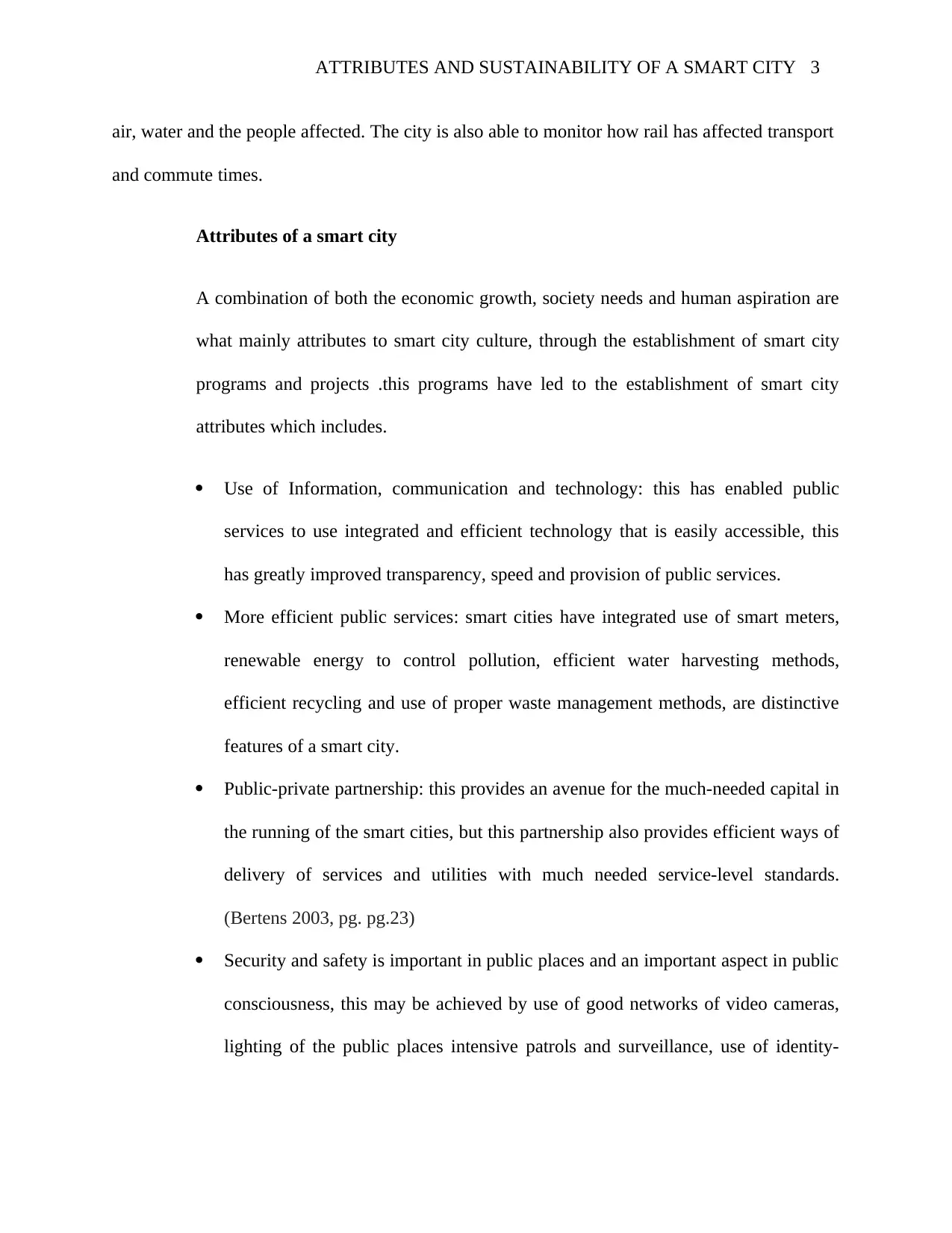
ATTRIBUTES AND SUSTAINABILITY OF A SMART CITY 3
air, water and the people affected. The city is also able to monitor how rail has affected transport
and commute times.
Attributes of a smart city
A combination of both the economic growth, society needs and human aspiration are
what mainly attributes to smart city culture, through the establishment of smart city
programs and projects .this programs have led to the establishment of smart city
attributes which includes.
Use of Information, communication and technology: this has enabled public
services to use integrated and efficient technology that is easily accessible, this
has greatly improved transparency, speed and provision of public services.
More efficient public services: smart cities have integrated use of smart meters,
renewable energy to control pollution, efficient water harvesting methods,
efficient recycling and use of proper waste management methods, are distinctive
features of a smart city.
Public-private partnership: this provides an avenue for the much-needed capital in
the running of the smart cities, but this partnership also provides efficient ways of
delivery of services and utilities with much needed service-level standards.
(Bertens 2003, pg. pg.23)
Security and safety is important in public places and an important aspect in public
consciousness, this may be achieved by use of good networks of video cameras,
lighting of the public places intensive patrols and surveillance, use of identity-
air, water and the people affected. The city is also able to monitor how rail has affected transport
and commute times.
Attributes of a smart city
A combination of both the economic growth, society needs and human aspiration are
what mainly attributes to smart city culture, through the establishment of smart city
programs and projects .this programs have led to the establishment of smart city
attributes which includes.
Use of Information, communication and technology: this has enabled public
services to use integrated and efficient technology that is easily accessible, this
has greatly improved transparency, speed and provision of public services.
More efficient public services: smart cities have integrated use of smart meters,
renewable energy to control pollution, efficient water harvesting methods,
efficient recycling and use of proper waste management methods, are distinctive
features of a smart city.
Public-private partnership: this provides an avenue for the much-needed capital in
the running of the smart cities, but this partnership also provides efficient ways of
delivery of services and utilities with much needed service-level standards.
(Bertens 2003, pg. pg.23)
Security and safety is important in public places and an important aspect in public
consciousness, this may be achieved by use of good networks of video cameras,
lighting of the public places intensive patrols and surveillance, use of identity-

ATTRIBUTES AND SUSTAINABILITY OF A SMART CITY 4
verified access, and quick response in case of an emergency are all attributes of a
smart city (Coaffee et.al 2009, pg. 489).
Financial independence: financial sustainability will only be achieved when there
are elaborate and extensive methods of tapping of all sources of a revenue
example use of proper taxation methods, ads payments and other means of getting
finance to run this city (Bertens 2003, pg. pg.23).
Participation of all the citizens: local government should include the citizens in
local issues example current apathy towards eviction election needs
comprehensive reversals and proper understanding of the local citizens.
Availability of social infrastructure: smart cities cannot develop in the absence of
sufficient social infrastructures examples schools, hospitals, public places,
entertainment joints and retail places (Catungal 2009, pg. 1095)
Good transit planning: the dream of a smart city is walk to work but the
availability of footpaths, bicycle paths and a good public transport network may
reduce in use of personal vehicles (Bertens 2003, pg. pg.23).
Green environment: green cities should minimize carbon pollution in the
environment, use eco-friendly materials, use of renewable energy, environmental
conservation and recycling of wastes are mandatory (Garrett 2016, pg. 1948).
Population estimates: population estimation is very critical and having population
estimates and size is important in provision and planning of services example the
energy needs and traffic control among others (Bertens 2003, pg. pg.23).
verified access, and quick response in case of an emergency are all attributes of a
smart city (Coaffee et.al 2009, pg. 489).
Financial independence: financial sustainability will only be achieved when there
are elaborate and extensive methods of tapping of all sources of a revenue
example use of proper taxation methods, ads payments and other means of getting
finance to run this city (Bertens 2003, pg. pg.23).
Participation of all the citizens: local government should include the citizens in
local issues example current apathy towards eviction election needs
comprehensive reversals and proper understanding of the local citizens.
Availability of social infrastructure: smart cities cannot develop in the absence of
sufficient social infrastructures examples schools, hospitals, public places,
entertainment joints and retail places (Catungal 2009, pg. 1095)
Good transit planning: the dream of a smart city is walk to work but the
availability of footpaths, bicycle paths and a good public transport network may
reduce in use of personal vehicles (Bertens 2003, pg. pg.23).
Green environment: green cities should minimize carbon pollution in the
environment, use eco-friendly materials, use of renewable energy, environmental
conservation and recycling of wastes are mandatory (Garrett 2016, pg. 1948).
Population estimates: population estimation is very critical and having population
estimates and size is important in provision and planning of services example the
energy needs and traffic control among others (Bertens 2003, pg. pg.23).
Secure Best Marks with AI Grader
Need help grading? Try our AI Grader for instant feedback on your assignments.

ATTRIBUTES AND SUSTAINABILITY OF A SMART CITY 5
(Fig; attributes of a smart city) (Iveson 2013, pg. 941)
When a city is not smart and sustainable it experiences infrastructure growth but due to
poor connectivity it faces the following challenges, more traffic jams, missed means of transport
example trains, buses, lack of proper coordination in times of disaster, shortage of resources
(water, electricity, and food) over duplication of resources, adverse effect on environment, and
lack of modes of communication. (McFarlane and Söderström 2017, pg.312)
There are other challenges that are faced by smart cities, the impact of climate change,
rural-urban migration, limited resources and environmental degradation. Use of technology and
connectivity is the key to turn a city into a smart city, the used technology should be sustainable,
resilient, affordable and available to its citizens. (McFarlane and Söderström 2017, pg.312)
Use of technology helps in the provision of smart services which in turn saves time and
makes life easier. The government also uses technology to communicate and get feedback from
its citizens on how they want their city to be run (Cochran, and Brunsell 2017, pg.372), the
(Fig; attributes of a smart city) (Iveson 2013, pg. 941)
When a city is not smart and sustainable it experiences infrastructure growth but due to
poor connectivity it faces the following challenges, more traffic jams, missed means of transport
example trains, buses, lack of proper coordination in times of disaster, shortage of resources
(water, electricity, and food) over duplication of resources, adverse effect on environment, and
lack of modes of communication. (McFarlane and Söderström 2017, pg.312)
There are other challenges that are faced by smart cities, the impact of climate change,
rural-urban migration, limited resources and environmental degradation. Use of technology and
connectivity is the key to turn a city into a smart city, the used technology should be sustainable,
resilient, affordable and available to its citizens. (McFarlane and Söderström 2017, pg.312)
Use of technology helps in the provision of smart services which in turn saves time and
makes life easier. The government also uses technology to communicate and get feedback from
its citizens on how they want their city to be run (Cochran, and Brunsell 2017, pg.372), the

ATTRIBUTES AND SUSTAINABILITY OF A SMART CITY 6
government also gathers intelligence concerning the city and through intelligence and smart
operations, the city becomes safer. There are various technologies that are used in smart cities
which includes; information and communication technology, internet of things, sensors,
geospatial technology, artificial intelligence, the block chain.
Information and communication technology.
Communication is very vital in the city to be considered a smart city, communication
channel should be a two -way communication. Information and communication technology
(ICT) acts as a medium of communication where the government communicates its plans to its
citizens and in return, the citizens can share their views on how they want their city to be
governed. Through ICT the government is able to identify and analyze the needs of its citizens
thus providing resources to address these issues online. (McFarlane and Söderström 2017,
pg.312)
ICT as a medium of communication can help the government in the collection of
intelligence which later is used to poll resources through analytical and deep learning of the
collected information. Smart city ICT infrastructure includes a software application, network
infrastructure (Cochran, and Brunsell 2017, pg.372), cloud computing, data platforms and access
devices. Other communication-related applications are, building management, smart grids,
physical safety and security, emergency response, good traffic and transport systems.
Opportunities and challenges of information and communication technology in smart
Cities. ICT has various uses in the running of a smart city which includes;
government also gathers intelligence concerning the city and through intelligence and smart
operations, the city becomes safer. There are various technologies that are used in smart cities
which includes; information and communication technology, internet of things, sensors,
geospatial technology, artificial intelligence, the block chain.
Information and communication technology.
Communication is very vital in the city to be considered a smart city, communication
channel should be a two -way communication. Information and communication technology
(ICT) acts as a medium of communication where the government communicates its plans to its
citizens and in return, the citizens can share their views on how they want their city to be
governed. Through ICT the government is able to identify and analyze the needs of its citizens
thus providing resources to address these issues online. (McFarlane and Söderström 2017,
pg.312)
ICT as a medium of communication can help the government in the collection of
intelligence which later is used to poll resources through analytical and deep learning of the
collected information. Smart city ICT infrastructure includes a software application, network
infrastructure (Cochran, and Brunsell 2017, pg.372), cloud computing, data platforms and access
devices. Other communication-related applications are, building management, smart grids,
physical safety and security, emergency response, good traffic and transport systems.
Opportunities and challenges of information and communication technology in smart
Cities. ICT has various uses in the running of a smart city which includes;
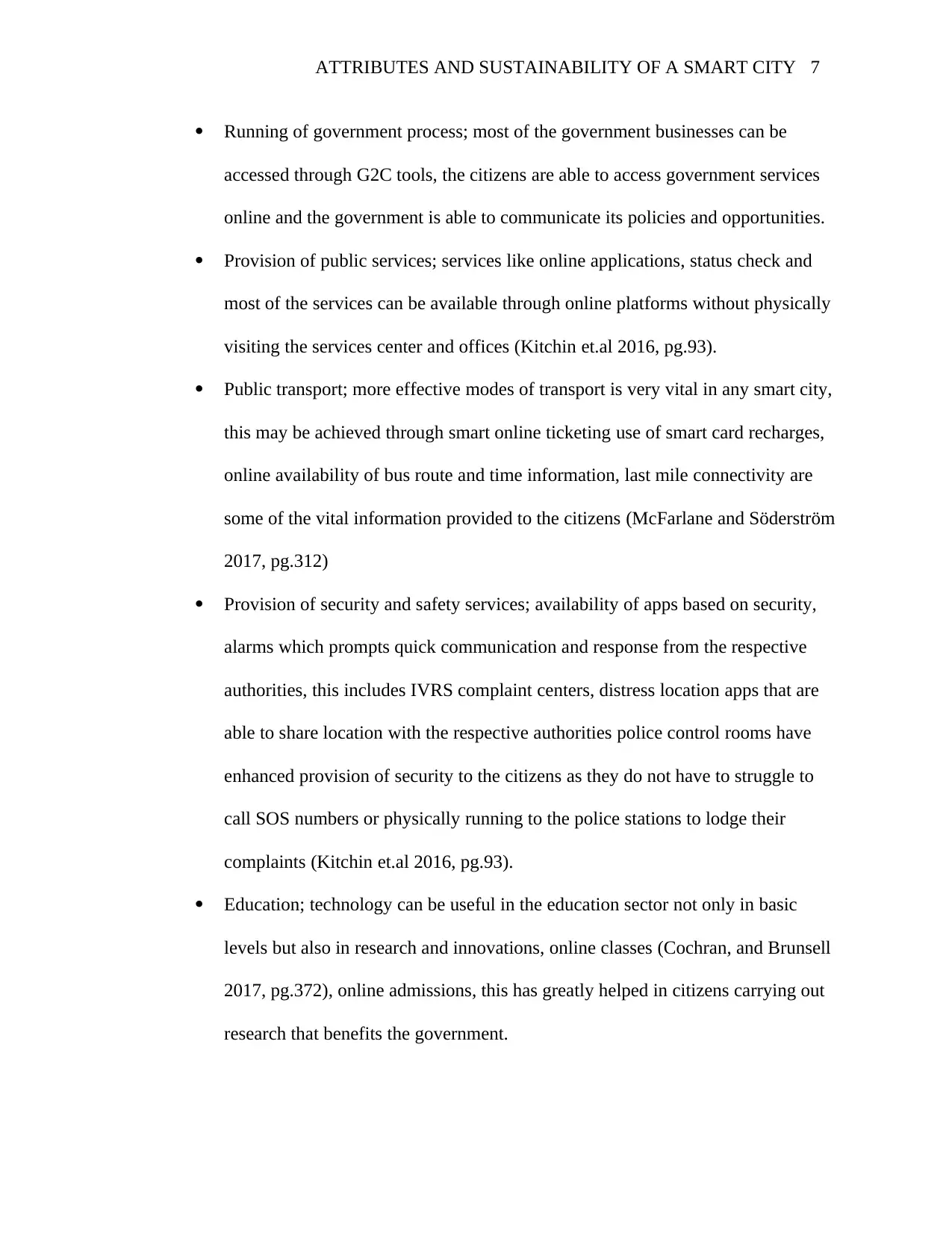
ATTRIBUTES AND SUSTAINABILITY OF A SMART CITY 7
Running of government process; most of the government businesses can be
accessed through G2C tools, the citizens are able to access government services
online and the government is able to communicate its policies and opportunities.
Provision of public services; services like online applications, status check and
most of the services can be available through online platforms without physically
visiting the services center and offices (Kitchin et.al 2016, pg.93).
Public transport; more effective modes of transport is very vital in any smart city,
this may be achieved through smart online ticketing use of smart card recharges,
online availability of bus route and time information, last mile connectivity are
some of the vital information provided to the citizens (McFarlane and Söderström
2017, pg.312)
Provision of security and safety services; availability of apps based on security,
alarms which prompts quick communication and response from the respective
authorities, this includes IVRS complaint centers, distress location apps that are
able to share location with the respective authorities police control rooms have
enhanced provision of security to the citizens as they do not have to struggle to
call SOS numbers or physically running to the police stations to lodge their
complaints (Kitchin et.al 2016, pg.93).
Education; technology can be useful in the education sector not only in basic
levels but also in research and innovations, online classes (Cochran, and Brunsell
2017, pg.372), online admissions, this has greatly helped in citizens carrying out
research that benefits the government.
Running of government process; most of the government businesses can be
accessed through G2C tools, the citizens are able to access government services
online and the government is able to communicate its policies and opportunities.
Provision of public services; services like online applications, status check and
most of the services can be available through online platforms without physically
visiting the services center and offices (Kitchin et.al 2016, pg.93).
Public transport; more effective modes of transport is very vital in any smart city,
this may be achieved through smart online ticketing use of smart card recharges,
online availability of bus route and time information, last mile connectivity are
some of the vital information provided to the citizens (McFarlane and Söderström
2017, pg.312)
Provision of security and safety services; availability of apps based on security,
alarms which prompts quick communication and response from the respective
authorities, this includes IVRS complaint centers, distress location apps that are
able to share location with the respective authorities police control rooms have
enhanced provision of security to the citizens as they do not have to struggle to
call SOS numbers or physically running to the police stations to lodge their
complaints (Kitchin et.al 2016, pg.93).
Education; technology can be useful in the education sector not only in basic
levels but also in research and innovations, online classes (Cochran, and Brunsell
2017, pg.372), online admissions, this has greatly helped in citizens carrying out
research that benefits the government.
Paraphrase This Document
Need a fresh take? Get an instant paraphrase of this document with our AI Paraphraser

ATTRIBUTES AND SUSTAINABILITY OF A SMART CITY 8
Health sector; technology has made it possible for online booking of doctor's
appointment in government hospitals, checking bed status, medicine supplies and
availability, payment of hospital fee through online platforms, this are some of the
benefits of using technology in the health sector(McFarlane and Söderström 2017,
pg.312).
(Fig; ICT in smart cities) (Iveson 2013, pg. 941)
Health sector; technology has made it possible for online booking of doctor's
appointment in government hospitals, checking bed status, medicine supplies and
availability, payment of hospital fee through online platforms, this are some of the
benefits of using technology in the health sector(McFarlane and Söderström 2017,
pg.312).
(Fig; ICT in smart cities) (Iveson 2013, pg. 941)
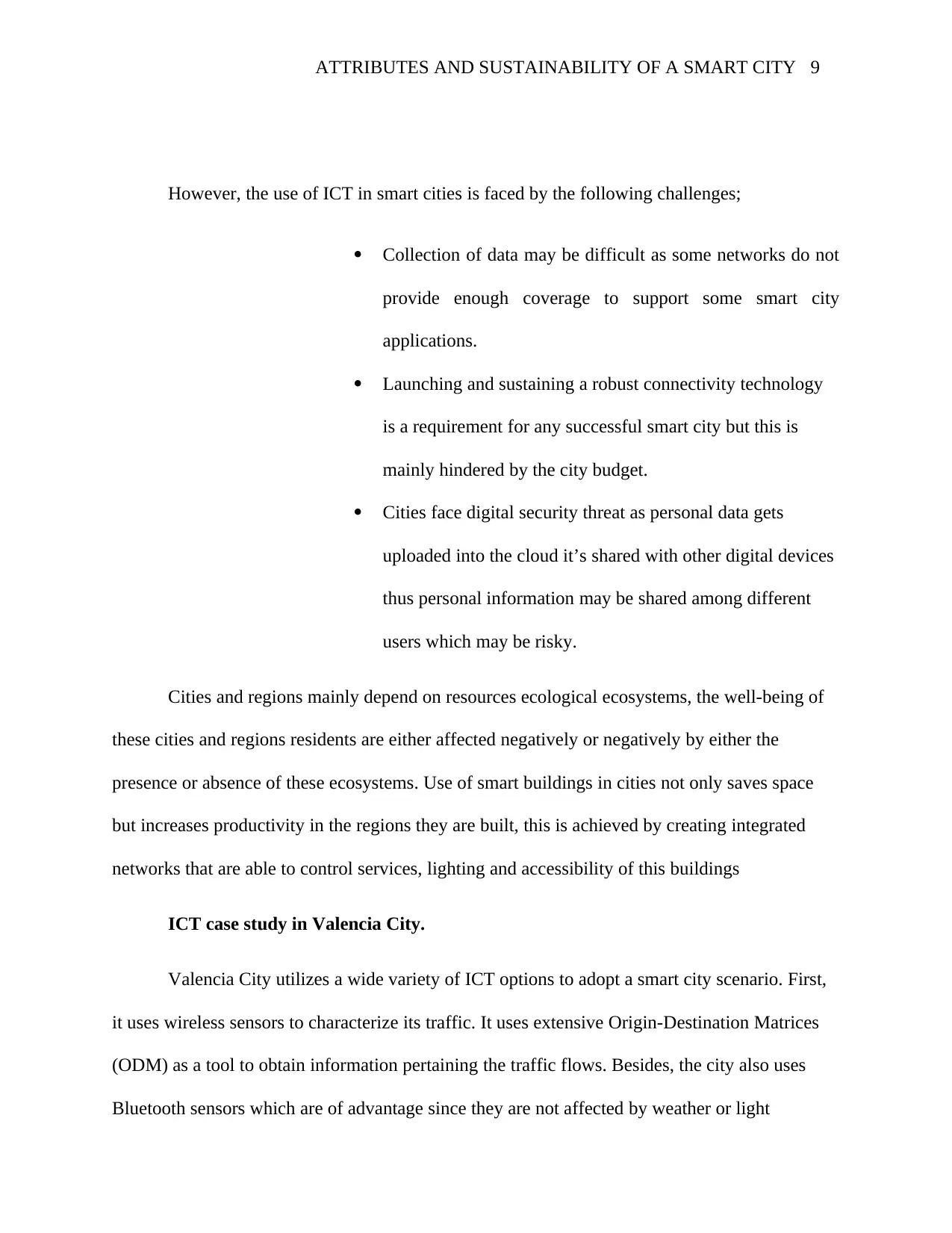
ATTRIBUTES AND SUSTAINABILITY OF A SMART CITY 9
However, the use of ICT in smart cities is faced by the following challenges;
Collection of data may be difficult as some networks do not
provide enough coverage to support some smart city
applications.
Launching and sustaining a robust connectivity technology
is a requirement for any successful smart city but this is
mainly hindered by the city budget.
Cities face digital security threat as personal data gets
uploaded into the cloud it’s shared with other digital devices
thus personal information may be shared among different
users which may be risky.
Cities and regions mainly depend on resources ecological ecosystems, the well-being of
these cities and regions residents are either affected negatively or negatively by either the
presence or absence of these ecosystems. Use of smart buildings in cities not only saves space
but increases productivity in the regions they are built, this is achieved by creating integrated
networks that are able to control services, lighting and accessibility of this buildings
ICT case study in Valencia City.
Valencia City utilizes a wide variety of ICT options to adopt a smart city scenario. First,
it uses wireless sensors to characterize its traffic. It uses extensive Origin-Destination Matrices
(ODM) as a tool to obtain information pertaining the traffic flows. Besides, the city also uses
Bluetooth sensors which are of advantage since they are not affected by weather or light
However, the use of ICT in smart cities is faced by the following challenges;
Collection of data may be difficult as some networks do not
provide enough coverage to support some smart city
applications.
Launching and sustaining a robust connectivity technology
is a requirement for any successful smart city but this is
mainly hindered by the city budget.
Cities face digital security threat as personal data gets
uploaded into the cloud it’s shared with other digital devices
thus personal information may be shared among different
users which may be risky.
Cities and regions mainly depend on resources ecological ecosystems, the well-being of
these cities and regions residents are either affected negatively or negatively by either the
presence or absence of these ecosystems. Use of smart buildings in cities not only saves space
but increases productivity in the regions they are built, this is achieved by creating integrated
networks that are able to control services, lighting and accessibility of this buildings
ICT case study in Valencia City.
Valencia City utilizes a wide variety of ICT options to adopt a smart city scenario. First,
it uses wireless sensors to characterize its traffic. It uses extensive Origin-Destination Matrices
(ODM) as a tool to obtain information pertaining the traffic flows. Besides, the city also uses
Bluetooth sensors which are of advantage since they are not affected by weather or light
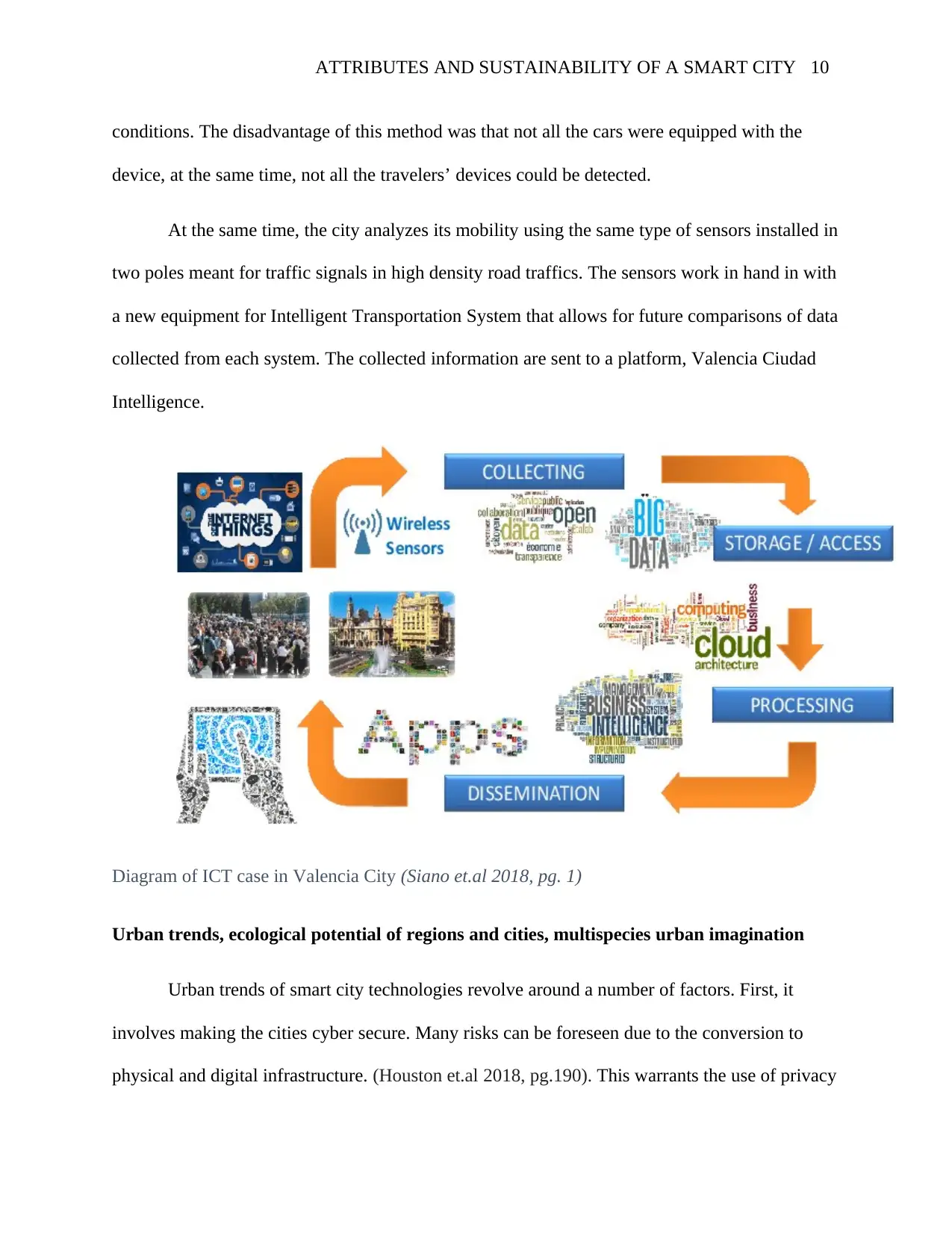
ATTRIBUTES AND SUSTAINABILITY OF A SMART CITY 10
conditions. The disadvantage of this method was that not all the cars were equipped with the
device, at the same time, not all the travelers’ devices could be detected.
At the same time, the city analyzes its mobility using the same type of sensors installed in
two poles meant for traffic signals in high density road traffics. The sensors work in hand in with
a new equipment for Intelligent Transportation System that allows for future comparisons of data
collected from each system. The collected information are sent to a platform, Valencia Ciudad
Intelligence.
Diagram of ICT case in Valencia City (Siano et.al 2018, pg. 1)
Urban trends, ecological potential of regions and cities, multispecies urban imagination
Urban trends of smart city technologies revolve around a number of factors. First, it
involves making the cities cyber secure. Many risks can be foreseen due to the conversion to
physical and digital infrastructure. (Houston et.al 2018, pg.190). This warrants the use of privacy
conditions. The disadvantage of this method was that not all the cars were equipped with the
device, at the same time, not all the travelers’ devices could be detected.
At the same time, the city analyzes its mobility using the same type of sensors installed in
two poles meant for traffic signals in high density road traffics. The sensors work in hand in with
a new equipment for Intelligent Transportation System that allows for future comparisons of data
collected from each system. The collected information are sent to a platform, Valencia Ciudad
Intelligence.
Diagram of ICT case in Valencia City (Siano et.al 2018, pg. 1)
Urban trends, ecological potential of regions and cities, multispecies urban imagination
Urban trends of smart city technologies revolve around a number of factors. First, it
involves making the cities cyber secure. Many risks can be foreseen due to the conversion to
physical and digital infrastructure. (Houston et.al 2018, pg.190). This warrants the use of privacy
Secure Best Marks with AI Grader
Need help grading? Try our AI Grader for instant feedback on your assignments.

ATTRIBUTES AND SUSTAINABILITY OF A SMART CITY 11
approaches and cybersecurity embedment in each development stage. Besides it also constitute
incorporation of renewable energy sources such as solar and wind energy. This facilitates
accomplishment of the goals for cities centered on people. Recently, most cities are shifting to
the engagement of citizens, governments as well as businesses to allow for provision of
improved services and higher life quality. (Houston et.al 2018, pg.190). This trend is different
from the initial one where smart cities majored on better connection of infrastructural insights.
Different cities and regions have the potential to walk the path of a smart city. Various
sectors can apply smart city technologies to create an outstanding scenario with less
complexities. Methods for planning for this phenomenon could be implemented by smart labs in
each of the cities. (Newman 2014, pg. 47). The areas that act as potential sites for integration of
the innovations include education, transport, urban water monitoring, urban security, mobility
analysis alongside many others.
Multi-species urban imagination involves a case where a city has well installed data
visualization and a co-designed network of environmental sensors. (Houston et.al 2018, pg.190).
It also accounts for the establishment of eco-cities as per global and local agendas that
incorporate every individual irrespective of their statuses.
Urban resilience
Resilient cities are cities that are able to minimize, prevent, mitigate, absorb and recover
from an impact of a disaster either economic, physical infrastructure or its social well-being, a
resilient city is able to absorb this impacts without shattering (Tkachenko et.al 2015, pg.211).
Smart cities install territorial management systems that are based on wireless sensor networks to
maintain and control any disruption that may occur and hider provision of essential services by
approaches and cybersecurity embedment in each development stage. Besides it also constitute
incorporation of renewable energy sources such as solar and wind energy. This facilitates
accomplishment of the goals for cities centered on people. Recently, most cities are shifting to
the engagement of citizens, governments as well as businesses to allow for provision of
improved services and higher life quality. (Houston et.al 2018, pg.190). This trend is different
from the initial one where smart cities majored on better connection of infrastructural insights.
Different cities and regions have the potential to walk the path of a smart city. Various
sectors can apply smart city technologies to create an outstanding scenario with less
complexities. Methods for planning for this phenomenon could be implemented by smart labs in
each of the cities. (Newman 2014, pg. 47). The areas that act as potential sites for integration of
the innovations include education, transport, urban water monitoring, urban security, mobility
analysis alongside many others.
Multi-species urban imagination involves a case where a city has well installed data
visualization and a co-designed network of environmental sensors. (Houston et.al 2018, pg.190).
It also accounts for the establishment of eco-cities as per global and local agendas that
incorporate every individual irrespective of their statuses.
Urban resilience
Resilient cities are cities that are able to minimize, prevent, mitigate, absorb and recover
from an impact of a disaster either economic, physical infrastructure or its social well-being, a
resilient city is able to absorb this impacts without shattering (Tkachenko et.al 2015, pg.211).
Smart cities install territorial management systems that are based on wireless sensor networks to
maintain and control any disruption that may occur and hider provision of essential services by
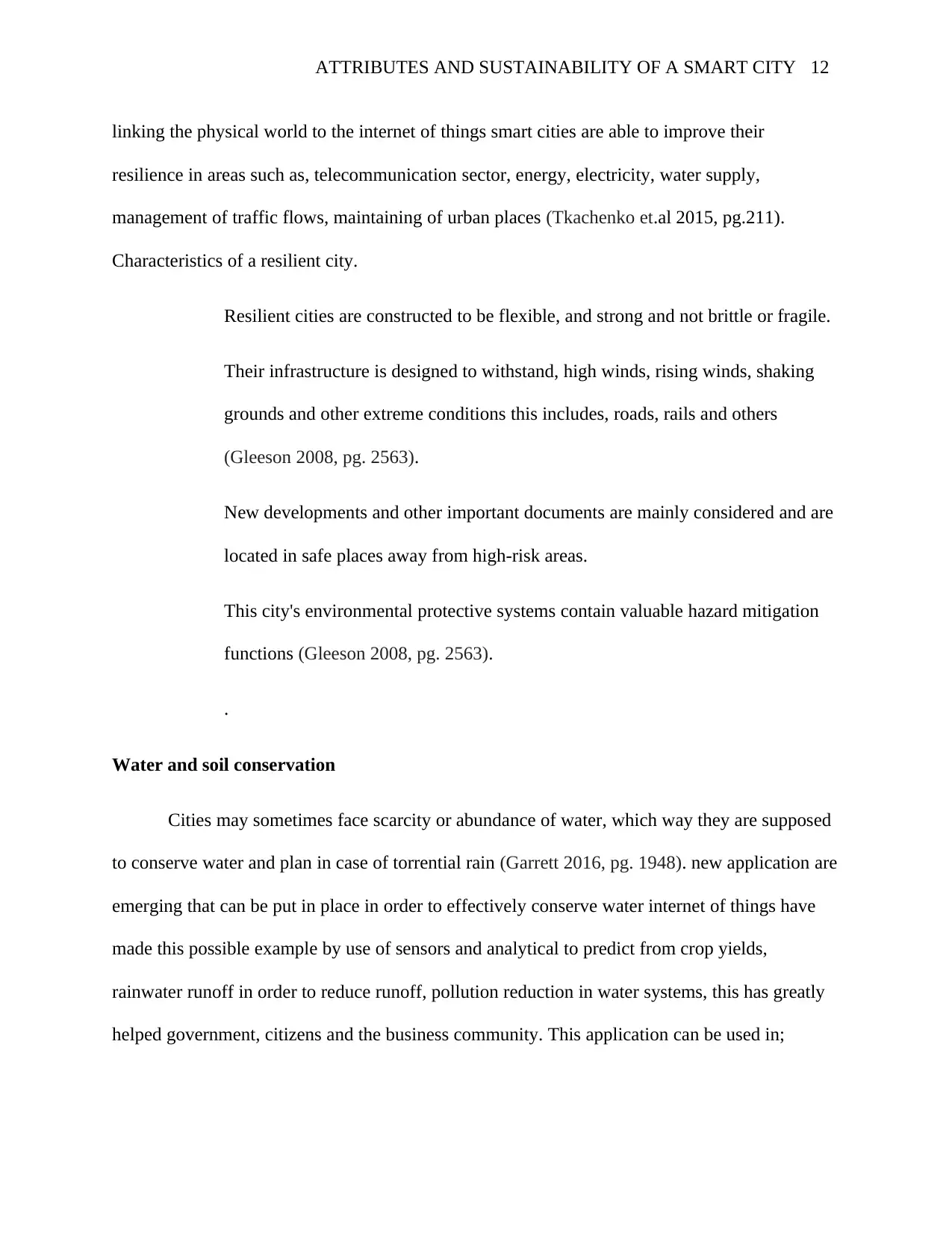
ATTRIBUTES AND SUSTAINABILITY OF A SMART CITY 12
linking the physical world to the internet of things smart cities are able to improve their
resilience in areas such as, telecommunication sector, energy, electricity, water supply,
management of traffic flows, maintaining of urban places (Tkachenko et.al 2015, pg.211).
Characteristics of a resilient city.
Resilient cities are constructed to be flexible, and strong and not brittle or fragile.
Their infrastructure is designed to withstand, high winds, rising winds, shaking
grounds and other extreme conditions this includes, roads, rails and others
(Gleeson 2008, pg. 2563).
New developments and other important documents are mainly considered and are
located in safe places away from high-risk areas.
This city's environmental protective systems contain valuable hazard mitigation
functions (Gleeson 2008, pg. 2563).
.
Water and soil conservation
Cities may sometimes face scarcity or abundance of water, which way they are supposed
to conserve water and plan in case of torrential rain (Garrett 2016, pg. 1948). new application are
emerging that can be put in place in order to effectively conserve water internet of things have
made this possible example by use of sensors and analytical to predict from crop yields,
rainwater runoff in order to reduce runoff, pollution reduction in water systems, this has greatly
helped government, citizens and the business community. This application can be used in;
linking the physical world to the internet of things smart cities are able to improve their
resilience in areas such as, telecommunication sector, energy, electricity, water supply,
management of traffic flows, maintaining of urban places (Tkachenko et.al 2015, pg.211).
Characteristics of a resilient city.
Resilient cities are constructed to be flexible, and strong and not brittle or fragile.
Their infrastructure is designed to withstand, high winds, rising winds, shaking
grounds and other extreme conditions this includes, roads, rails and others
(Gleeson 2008, pg. 2563).
New developments and other important documents are mainly considered and are
located in safe places away from high-risk areas.
This city's environmental protective systems contain valuable hazard mitigation
functions (Gleeson 2008, pg. 2563).
.
Water and soil conservation
Cities may sometimes face scarcity or abundance of water, which way they are supposed
to conserve water and plan in case of torrential rain (Garrett 2016, pg. 1948). new application are
emerging that can be put in place in order to effectively conserve water internet of things have
made this possible example by use of sensors and analytical to predict from crop yields,
rainwater runoff in order to reduce runoff, pollution reduction in water systems, this has greatly
helped government, citizens and the business community. This application can be used in;
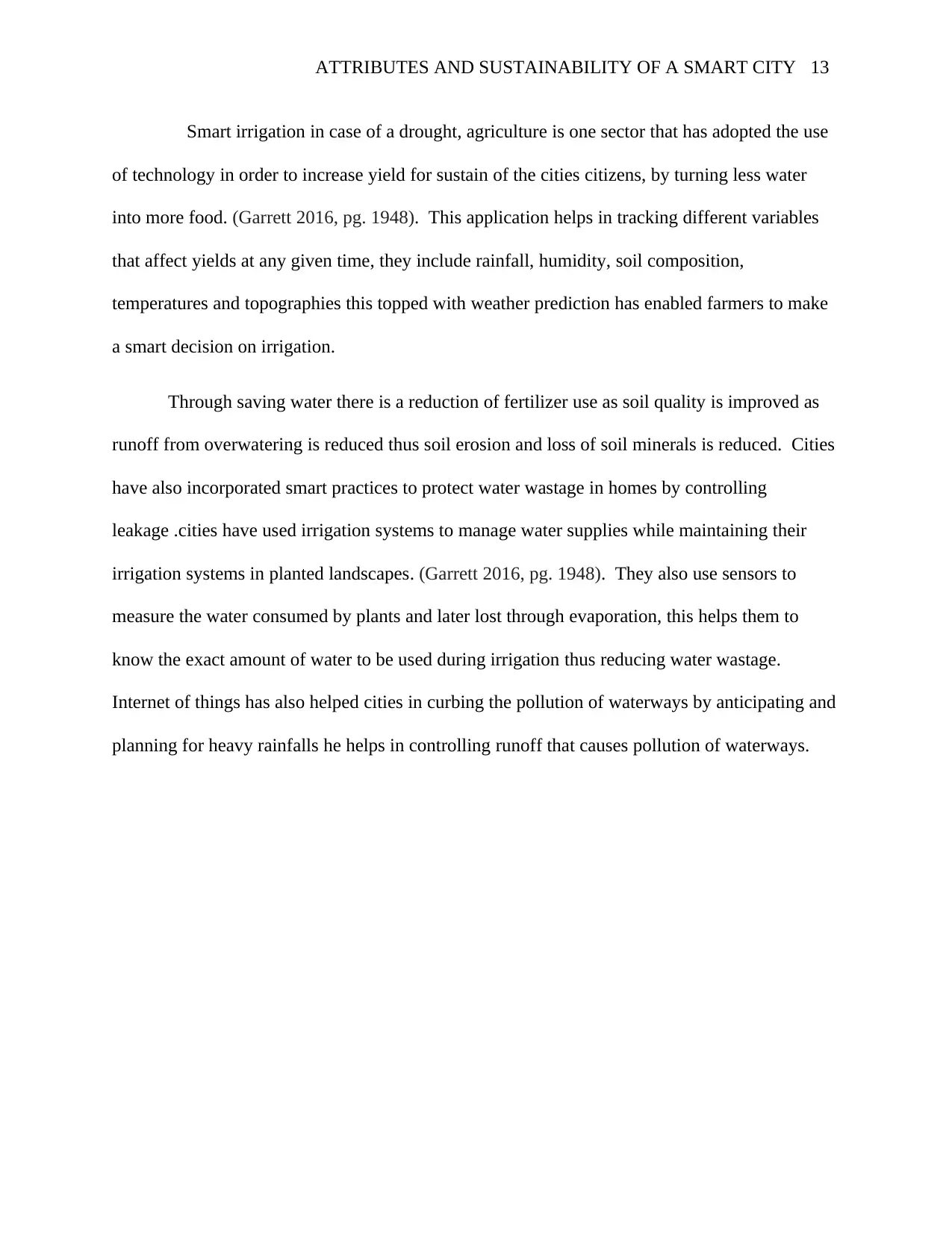
ATTRIBUTES AND SUSTAINABILITY OF A SMART CITY 13
Smart irrigation in case of a drought, agriculture is one sector that has adopted the use
of technology in order to increase yield for sustain of the cities citizens, by turning less water
into more food. (Garrett 2016, pg. 1948). This application helps in tracking different variables
that affect yields at any given time, they include rainfall, humidity, soil composition,
temperatures and topographies this topped with weather prediction has enabled farmers to make
a smart decision on irrigation.
Through saving water there is a reduction of fertilizer use as soil quality is improved as
runoff from overwatering is reduced thus soil erosion and loss of soil minerals is reduced. Cities
have also incorporated smart practices to protect water wastage in homes by controlling
leakage .cities have used irrigation systems to manage water supplies while maintaining their
irrigation systems in planted landscapes. (Garrett 2016, pg. 1948). They also use sensors to
measure the water consumed by plants and later lost through evaporation, this helps them to
know the exact amount of water to be used during irrigation thus reducing water wastage.
Internet of things has also helped cities in curbing the pollution of waterways by anticipating and
planning for heavy rainfalls he helps in controlling runoff that causes pollution of waterways.
Smart irrigation in case of a drought, agriculture is one sector that has adopted the use
of technology in order to increase yield for sustain of the cities citizens, by turning less water
into more food. (Garrett 2016, pg. 1948). This application helps in tracking different variables
that affect yields at any given time, they include rainfall, humidity, soil composition,
temperatures and topographies this topped with weather prediction has enabled farmers to make
a smart decision on irrigation.
Through saving water there is a reduction of fertilizer use as soil quality is improved as
runoff from overwatering is reduced thus soil erosion and loss of soil minerals is reduced. Cities
have also incorporated smart practices to protect water wastage in homes by controlling
leakage .cities have used irrigation systems to manage water supplies while maintaining their
irrigation systems in planted landscapes. (Garrett 2016, pg. 1948). They also use sensors to
measure the water consumed by plants and later lost through evaporation, this helps them to
know the exact amount of water to be used during irrigation thus reducing water wastage.
Internet of things has also helped cities in curbing the pollution of waterways by anticipating and
planning for heavy rainfalls he helps in controlling runoff that causes pollution of waterways.
Paraphrase This Document
Need a fresh take? Get an instant paraphrase of this document with our AI Paraphraser
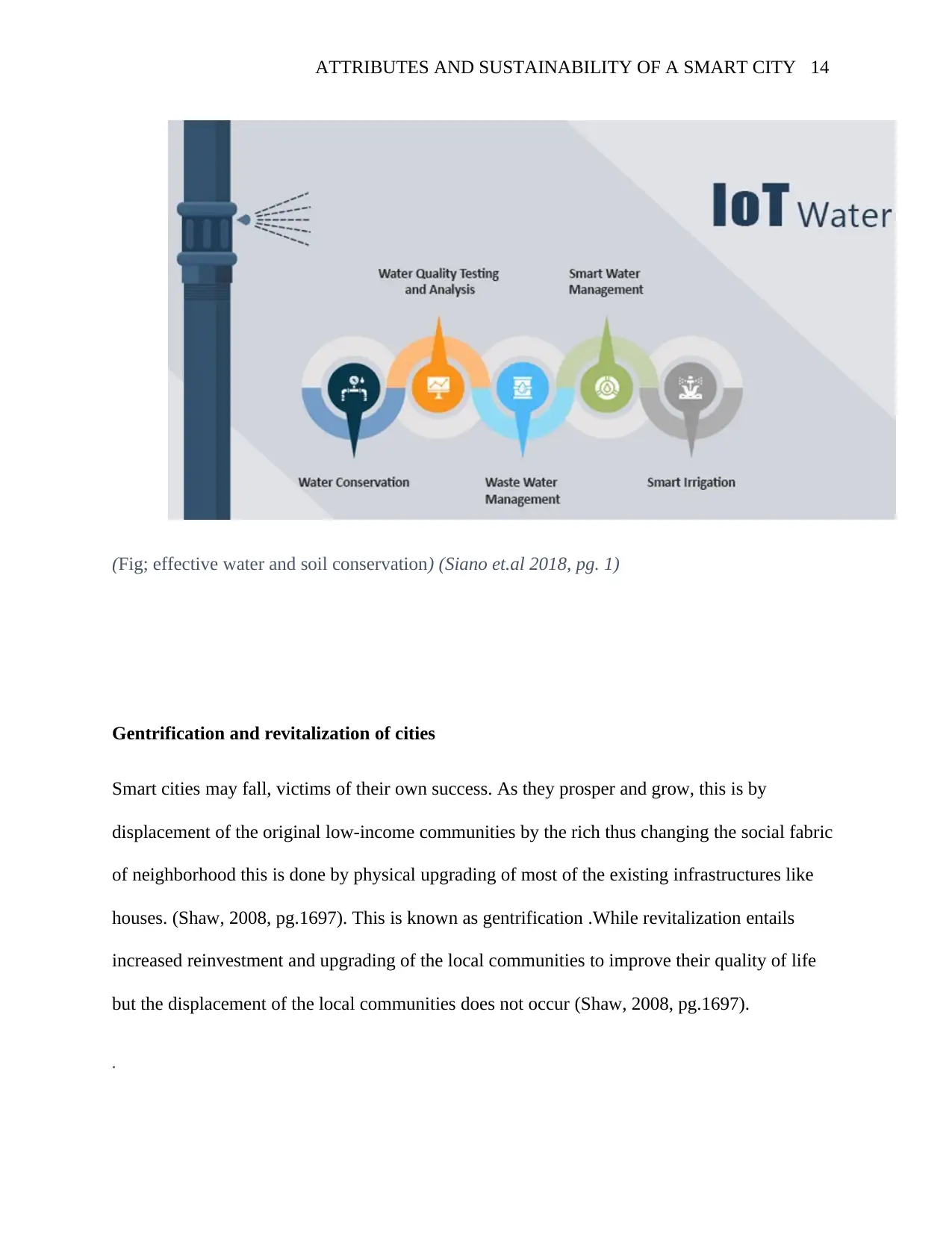
ATTRIBUTES AND SUSTAINABILITY OF A SMART CITY 14
(Fig; effective water and soil conservation) (Siano et.al 2018, pg. 1)
Gentrification and revitalization of cities
Smart cities may fall, victims of their own success. As they prosper and grow, this is by
displacement of the original low-income communities by the rich thus changing the social fabric
of neighborhood this is done by physical upgrading of most of the existing infrastructures like
houses. (Shaw, 2008, pg.1697). This is known as gentrification .While revitalization entails
increased reinvestment and upgrading of the local communities to improve their quality of life
but the displacement of the local communities does not occur (Shaw, 2008, pg.1697).
.
(Fig; effective water and soil conservation) (Siano et.al 2018, pg. 1)
Gentrification and revitalization of cities
Smart cities may fall, victims of their own success. As they prosper and grow, this is by
displacement of the original low-income communities by the rich thus changing the social fabric
of neighborhood this is done by physical upgrading of most of the existing infrastructures like
houses. (Shaw, 2008, pg.1697). This is known as gentrification .While revitalization entails
increased reinvestment and upgrading of the local communities to improve their quality of life
but the displacement of the local communities does not occur (Shaw, 2008, pg.1697).
.
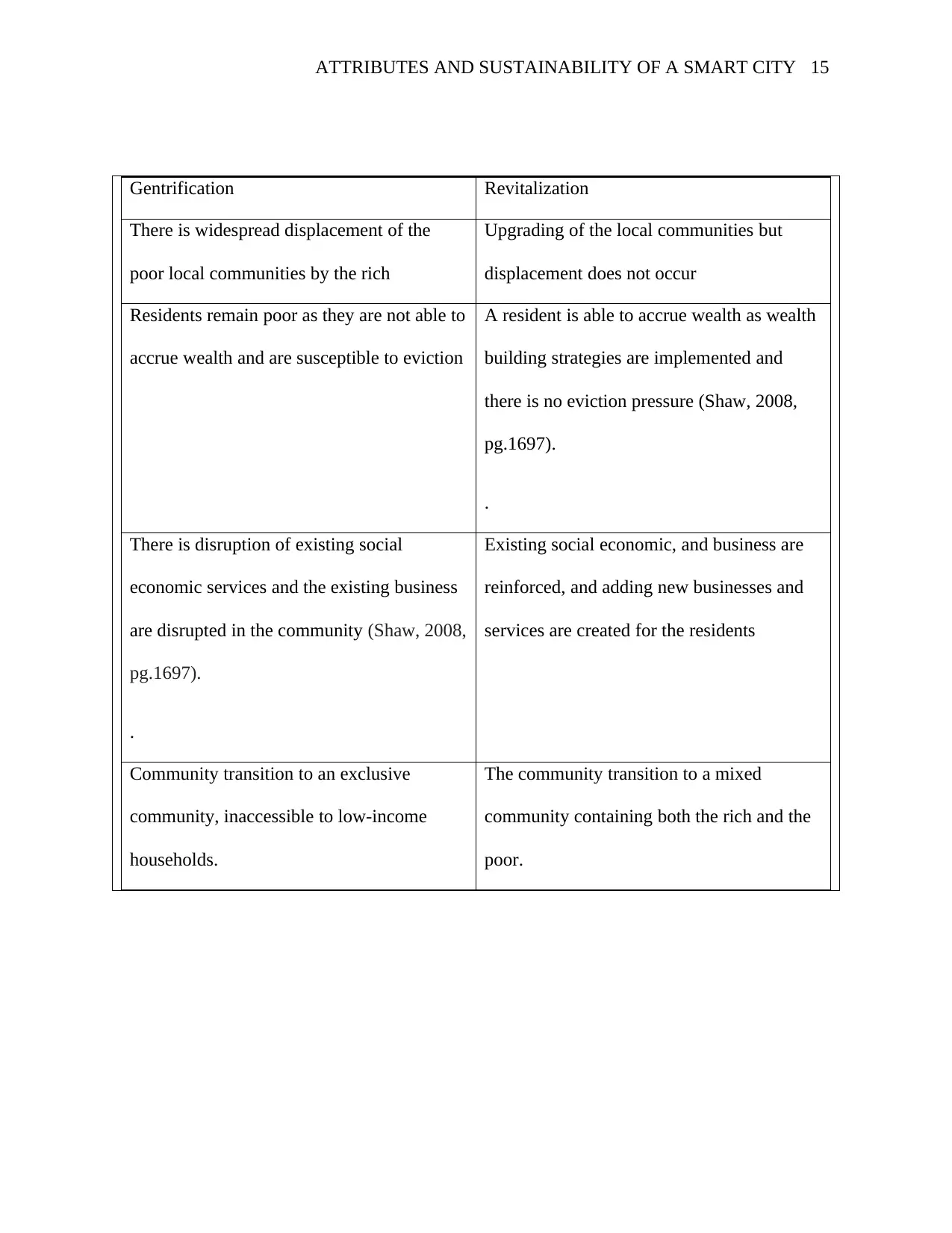
ATTRIBUTES AND SUSTAINABILITY OF A SMART CITY 15
Gentrification Revitalization
There is widespread displacement of the
poor local communities by the rich
Upgrading of the local communities but
displacement does not occur
Residents remain poor as they are not able to
accrue wealth and are susceptible to eviction
A resident is able to accrue wealth as wealth
building strategies are implemented and
there is no eviction pressure (Shaw, 2008,
pg.1697).
.
There is disruption of existing social
economic services and the existing business
are disrupted in the community (Shaw, 2008,
pg.1697).
.
Existing social economic, and business are
reinforced, and adding new businesses and
services are created for the residents
Community transition to an exclusive
community, inaccessible to low-income
households.
The community transition to a mixed
community containing both the rich and the
poor.
Gentrification Revitalization
There is widespread displacement of the
poor local communities by the rich
Upgrading of the local communities but
displacement does not occur
Residents remain poor as they are not able to
accrue wealth and are susceptible to eviction
A resident is able to accrue wealth as wealth
building strategies are implemented and
there is no eviction pressure (Shaw, 2008,
pg.1697).
.
There is disruption of existing social
economic services and the existing business
are disrupted in the community (Shaw, 2008,
pg.1697).
.
Existing social economic, and business are
reinforced, and adding new businesses and
services are created for the residents
Community transition to an exclusive
community, inaccessible to low-income
households.
The community transition to a mixed
community containing both the rich and the
poor.

ATTRIBUTES AND SUSTAINABILITY OF A SMART CITY 16
Diagram of revitalization and gentrification in Chicago city (Shaw, 2008, pg.1697).
Urban mobility
Cities have implemented new revolutionary modes of transport to move them around this
includes, car sharing, walking, biking, use of public transport instead of owning gas-powered
vehicles. (Harvey 2003, pg. 939). Through smart mobility, there is reduced traffic congestion,
Diagram of revitalization and gentrification in Chicago city (Shaw, 2008, pg.1697).
Urban mobility
Cities have implemented new revolutionary modes of transport to move them around this
includes, car sharing, walking, biking, use of public transport instead of owning gas-powered
vehicles. (Harvey 2003, pg. 939). Through smart mobility, there is reduced traffic congestion,
Secure Best Marks with AI Grader
Need help grading? Try our AI Grader for instant feedback on your assignments.
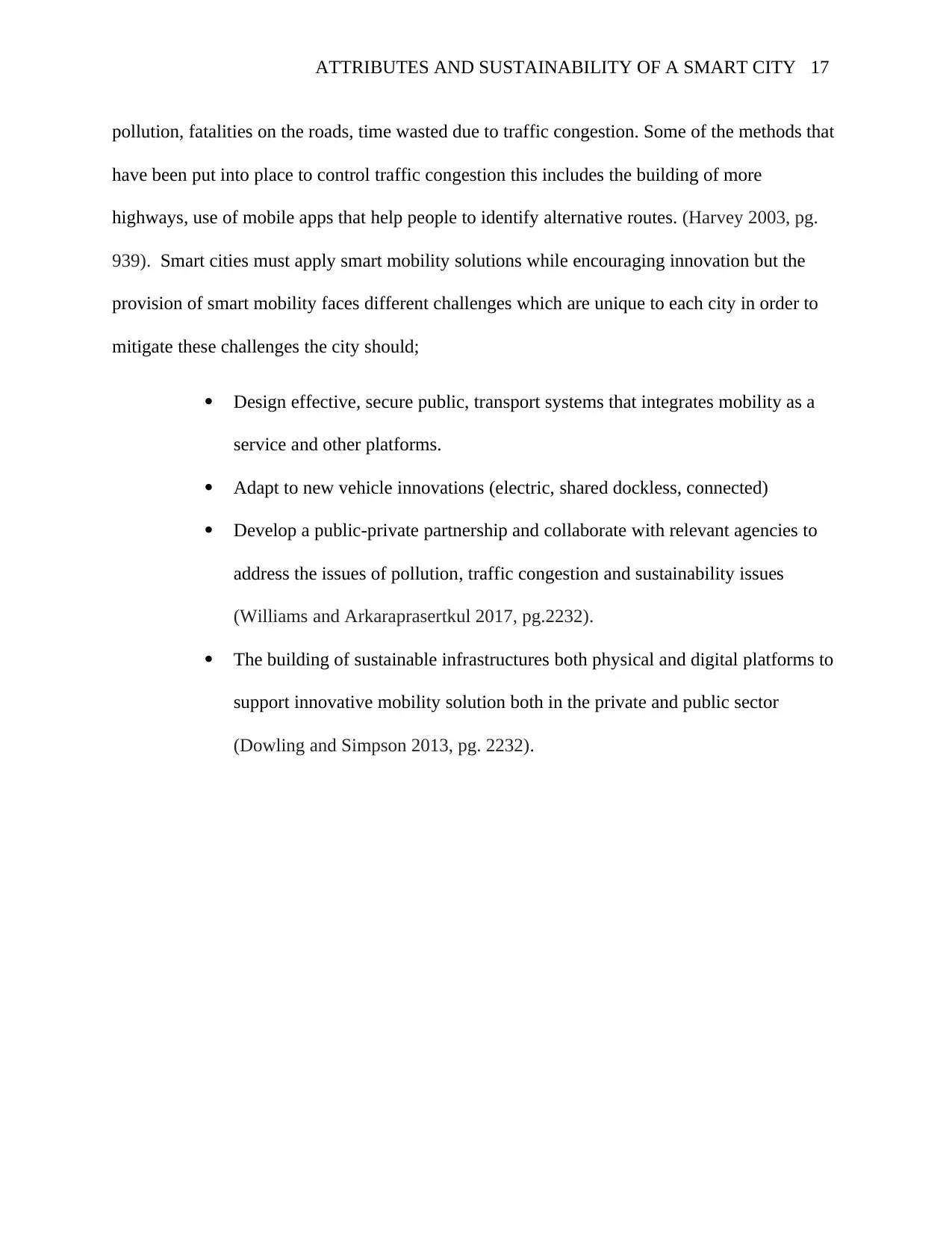
ATTRIBUTES AND SUSTAINABILITY OF A SMART CITY 17
pollution, fatalities on the roads, time wasted due to traffic congestion. Some of the methods that
have been put into place to control traffic congestion this includes the building of more
highways, use of mobile apps that help people to identify alternative routes. (Harvey 2003, pg.
939). Smart cities must apply smart mobility solutions while encouraging innovation but the
provision of smart mobility faces different challenges which are unique to each city in order to
mitigate these challenges the city should;
Design effective, secure public, transport systems that integrates mobility as a
service and other platforms.
Adapt to new vehicle innovations (electric, shared dockless, connected)
Develop a public-private partnership and collaborate with relevant agencies to
address the issues of pollution, traffic congestion and sustainability issues
(Williams and Arkaraprasertkul 2017, pg.2232).
The building of sustainable infrastructures both physical and digital platforms to
support innovative mobility solution both in the private and public sector
(Dowling and Simpson 2013, pg. 2232).
pollution, fatalities on the roads, time wasted due to traffic congestion. Some of the methods that
have been put into place to control traffic congestion this includes the building of more
highways, use of mobile apps that help people to identify alternative routes. (Harvey 2003, pg.
939). Smart cities must apply smart mobility solutions while encouraging innovation but the
provision of smart mobility faces different challenges which are unique to each city in order to
mitigate these challenges the city should;
Design effective, secure public, transport systems that integrates mobility as a
service and other platforms.
Adapt to new vehicle innovations (electric, shared dockless, connected)
Develop a public-private partnership and collaborate with relevant agencies to
address the issues of pollution, traffic congestion and sustainability issues
(Williams and Arkaraprasertkul 2017, pg.2232).
The building of sustainable infrastructures both physical and digital platforms to
support innovative mobility solution both in the private and public sector
(Dowling and Simpson 2013, pg. 2232).
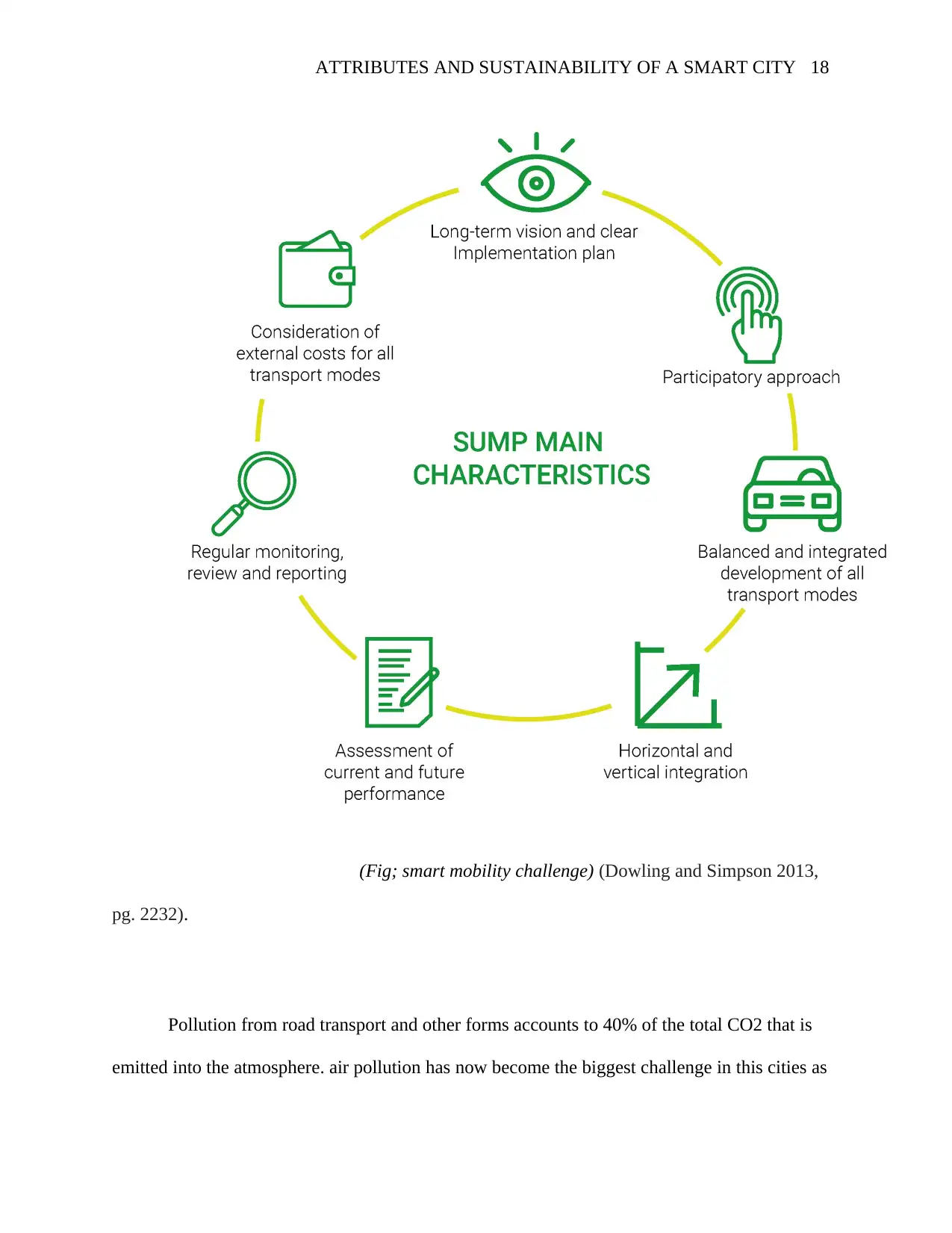
ATTRIBUTES AND SUSTAINABILITY OF A SMART CITY 18
(Fig; smart mobility challenge) (Dowling and Simpson 2013,
pg. 2232).
Pollution from road transport and other forms accounts to 40% of the total CO2 that is
emitted into the atmosphere. air pollution has now become the biggest challenge in this cities as
(Fig; smart mobility challenge) (Dowling and Simpson 2013,
pg. 2232).
Pollution from road transport and other forms accounts to 40% of the total CO2 that is
emitted into the atmosphere. air pollution has now become the biggest challenge in this cities as
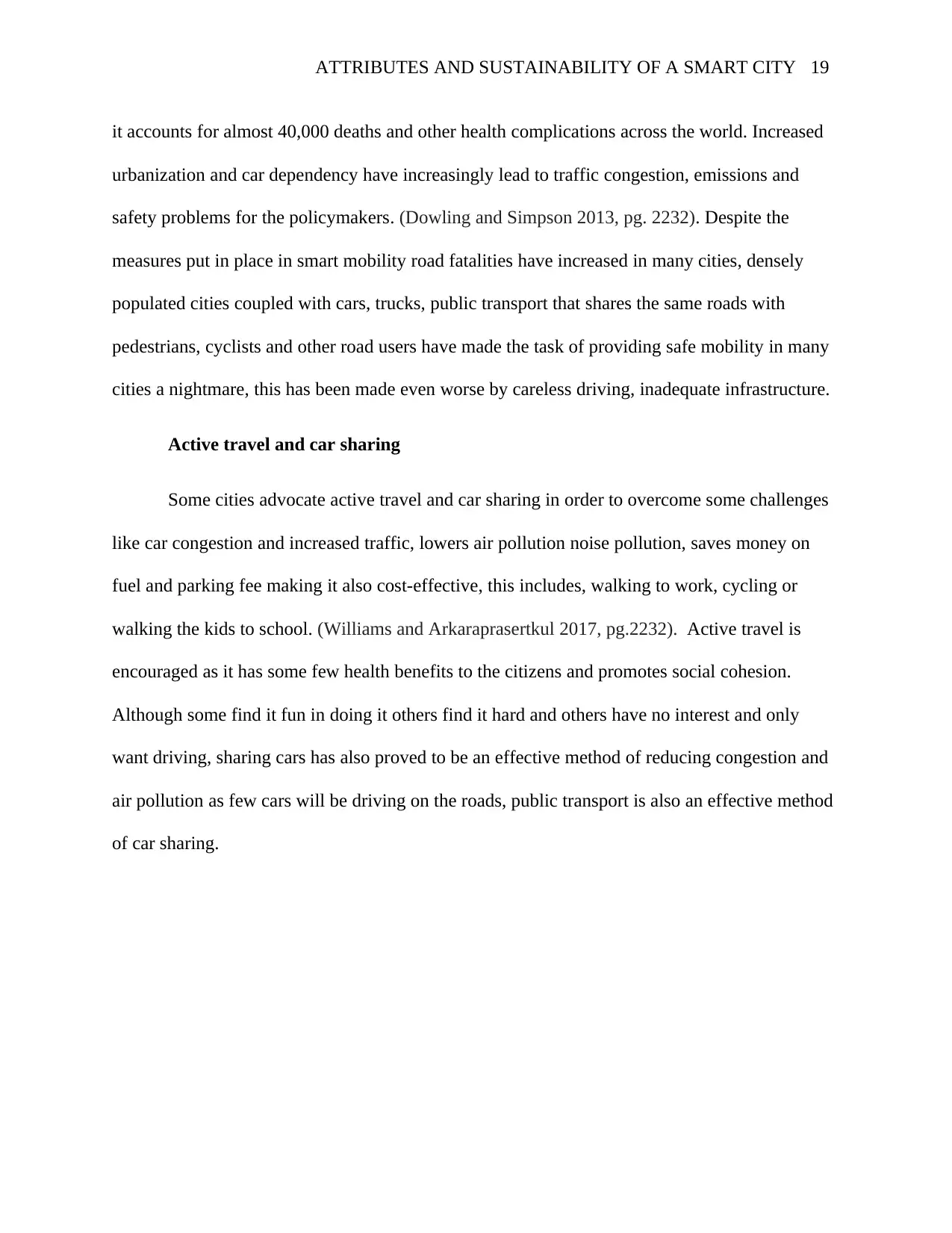
ATTRIBUTES AND SUSTAINABILITY OF A SMART CITY 19
it accounts for almost 40,000 deaths and other health complications across the world. Increased
urbanization and car dependency have increasingly lead to traffic congestion, emissions and
safety problems for the policymakers. (Dowling and Simpson 2013, pg. 2232). Despite the
measures put in place in smart mobility road fatalities have increased in many cities, densely
populated cities coupled with cars, trucks, public transport that shares the same roads with
pedestrians, cyclists and other road users have made the task of providing safe mobility in many
cities a nightmare, this has been made even worse by careless driving, inadequate infrastructure.
Active travel and car sharing
Some cities advocate active travel and car sharing in order to overcome some challenges
like car congestion and increased traffic, lowers air pollution noise pollution, saves money on
fuel and parking fee making it also cost-effective, this includes, walking to work, cycling or
walking the kids to school. (Williams and Arkaraprasertkul 2017, pg.2232). Active travel is
encouraged as it has some few health benefits to the citizens and promotes social cohesion.
Although some find it fun in doing it others find it hard and others have no interest and only
want driving, sharing cars has also proved to be an effective method of reducing congestion and
air pollution as few cars will be driving on the roads, public transport is also an effective method
of car sharing.
it accounts for almost 40,000 deaths and other health complications across the world. Increased
urbanization and car dependency have increasingly lead to traffic congestion, emissions and
safety problems for the policymakers. (Dowling and Simpson 2013, pg. 2232). Despite the
measures put in place in smart mobility road fatalities have increased in many cities, densely
populated cities coupled with cars, trucks, public transport that shares the same roads with
pedestrians, cyclists and other road users have made the task of providing safe mobility in many
cities a nightmare, this has been made even worse by careless driving, inadequate infrastructure.
Active travel and car sharing
Some cities advocate active travel and car sharing in order to overcome some challenges
like car congestion and increased traffic, lowers air pollution noise pollution, saves money on
fuel and parking fee making it also cost-effective, this includes, walking to work, cycling or
walking the kids to school. (Williams and Arkaraprasertkul 2017, pg.2232). Active travel is
encouraged as it has some few health benefits to the citizens and promotes social cohesion.
Although some find it fun in doing it others find it hard and others have no interest and only
want driving, sharing cars has also proved to be an effective method of reducing congestion and
air pollution as few cars will be driving on the roads, public transport is also an effective method
of car sharing.
Paraphrase This Document
Need a fresh take? Get an instant paraphrase of this document with our AI Paraphraser

ATTRIBUTES AND SUSTAINABILITY OF A SMART CITY 20
(Fig; active travel) (Dowling and Simpson 2013, pg. 2232).
The right to the city and Sydney green bans
The Sidney green bans acted as an activism for the environment. It was established by
builders who were employed to construct precincts of shopping, luxury and office-block
apartments and skyscrapers. Dowling and Simpson 2013, pg. 2232). The construction was
rapidly eating up the green Sidney spaces in the name of replacement of old residential and
commercial buildings. Due to this, the laborers who worked on the sites later refused to take part
in projects which were socially or environmentally undesired.
The bans focused on three main agendas. First, to protect open Sidney spaces from
various development forms, second, to defend the existing stock of housing from being
demolished to allow for establishment of high-rise buildings and freeways. Thirdly, it aimed at
preserving the buildings that were categorized as old-style from shopping or office-blocks
replacements. (Williams and Arkaraprasertkul 2017, pg.2232). The laborers, based at the New
(Fig; active travel) (Dowling and Simpson 2013, pg. 2232).
The right to the city and Sydney green bans
The Sidney green bans acted as an activism for the environment. It was established by
builders who were employed to construct precincts of shopping, luxury and office-block
apartments and skyscrapers. Dowling and Simpson 2013, pg. 2232). The construction was
rapidly eating up the green Sidney spaces in the name of replacement of old residential and
commercial buildings. Due to this, the laborers who worked on the sites later refused to take part
in projects which were socially or environmentally undesired.
The bans focused on three main agendas. First, to protect open Sidney spaces from
various development forms, second, to defend the existing stock of housing from being
demolished to allow for establishment of high-rise buildings and freeways. Thirdly, it aimed at
preserving the buildings that were categorized as old-style from shopping or office-blocks
replacements. (Williams and Arkaraprasertkul 2017, pg.2232). The laborers, based at the New
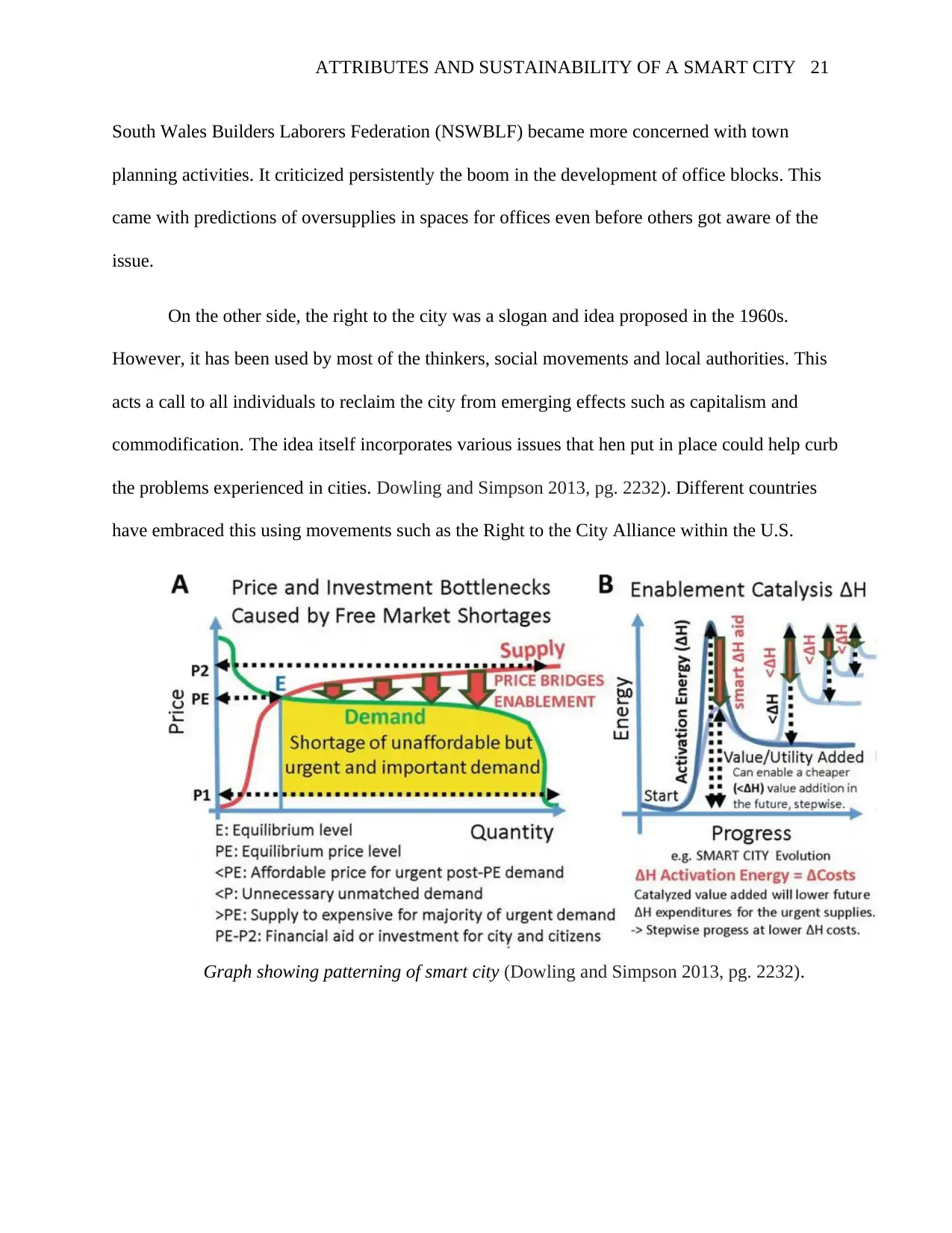
ATTRIBUTES AND SUSTAINABILITY OF A SMART CITY 21
South Wales Builders Laborers Federation (NSWBLF) became more concerned with town
planning activities. It criticized persistently the boom in the development of office blocks. This
came with predictions of oversupplies in spaces for offices even before others got aware of the
issue.
On the other side, the right to the city was a slogan and idea proposed in the 1960s.
However, it has been used by most of the thinkers, social movements and local authorities. This
acts a call to all individuals to reclaim the city from emerging effects such as capitalism and
commodification. The idea itself incorporates various issues that hen put in place could help curb
the problems experienced in cities. Dowling and Simpson 2013, pg. 2232). Different countries
have embraced this using movements such as the Right to the City Alliance within the U.S.
Graph showing patterning of smart city (Dowling and Simpson 2013, pg. 2232).
South Wales Builders Laborers Federation (NSWBLF) became more concerned with town
planning activities. It criticized persistently the boom in the development of office blocks. This
came with predictions of oversupplies in spaces for offices even before others got aware of the
issue.
On the other side, the right to the city was a slogan and idea proposed in the 1960s.
However, it has been used by most of the thinkers, social movements and local authorities. This
acts a call to all individuals to reclaim the city from emerging effects such as capitalism and
commodification. The idea itself incorporates various issues that hen put in place could help curb
the problems experienced in cities. Dowling and Simpson 2013, pg. 2232). Different countries
have embraced this using movements such as the Right to the City Alliance within the U.S.
Graph showing patterning of smart city (Dowling and Simpson 2013, pg. 2232).
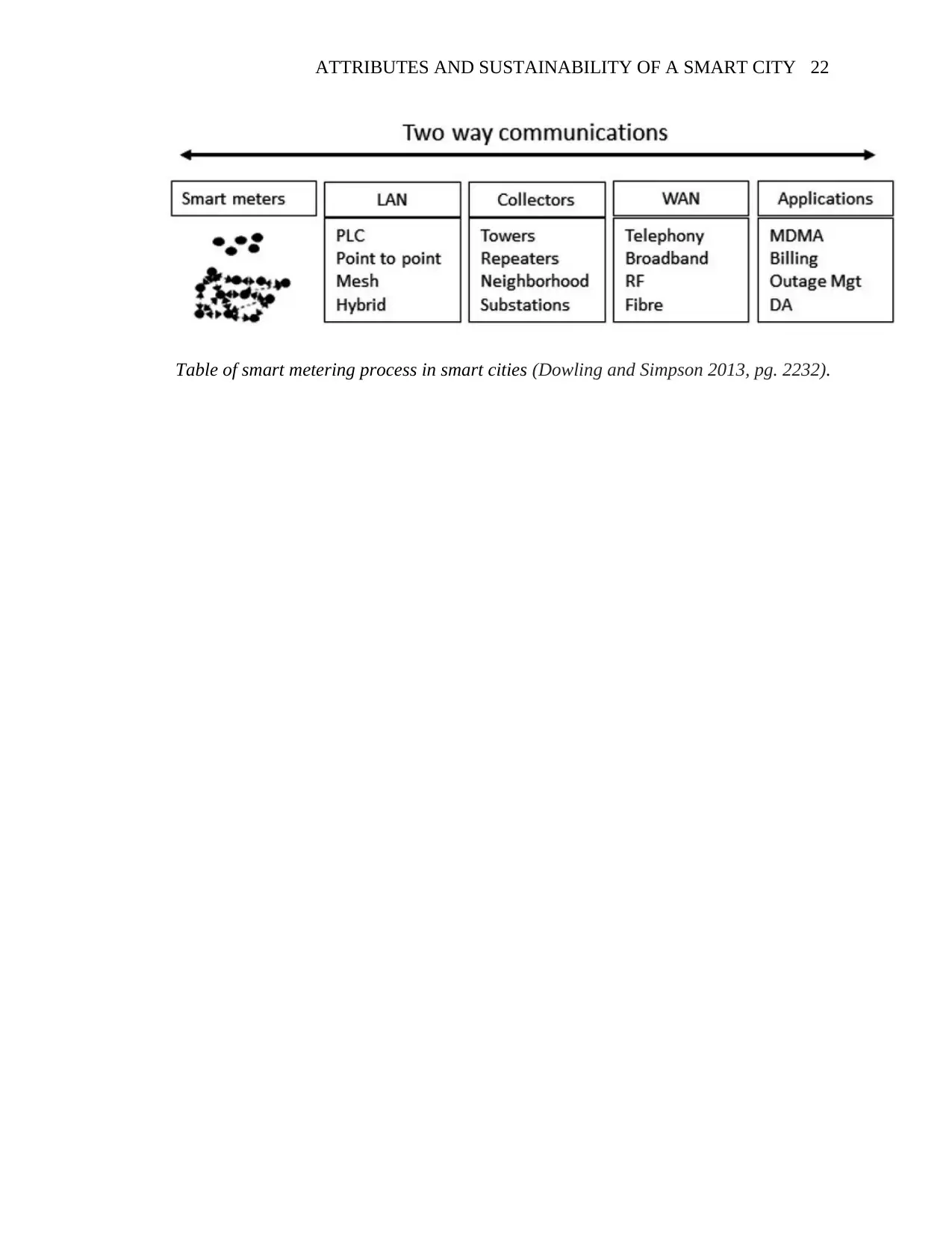
ATTRIBUTES AND SUSTAINABILITY OF A SMART CITY 22
Table of smart metering process in smart cities (Dowling and Simpson 2013, pg. 2232).
Table of smart metering process in smart cities (Dowling and Simpson 2013, pg. 2232).
Secure Best Marks with AI Grader
Need help grading? Try our AI Grader for instant feedback on your assignments.
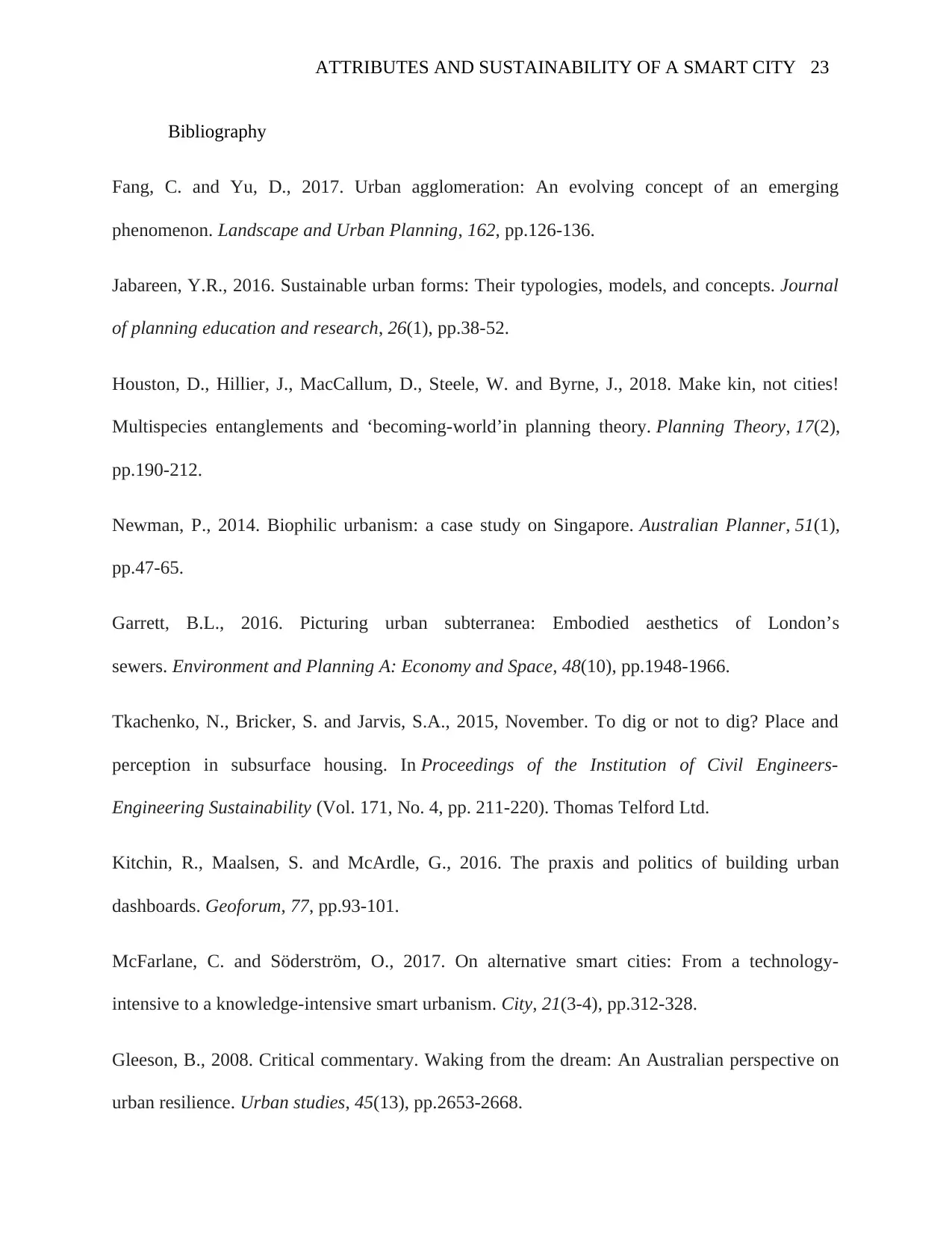
ATTRIBUTES AND SUSTAINABILITY OF A SMART CITY 23
Bibliography
Fang, C. and Yu, D., 2017. Urban agglomeration: An evolving concept of an emerging
phenomenon. Landscape and Urban Planning, 162, pp.126-136.
Jabareen, Y.R., 2016. Sustainable urban forms: Their typologies, models, and concepts. Journal
of planning education and research, 26(1), pp.38-52.
Houston, D., Hillier, J., MacCallum, D., Steele, W. and Byrne, J., 2018. Make kin, not cities!
Multispecies entanglements and ‘becoming-world’in planning theory. Planning Theory, 17(2),
pp.190-212.
Newman, P., 2014. Biophilic urbanism: a case study on Singapore. Australian Planner, 51(1),
pp.47-65.
Garrett, B.L., 2016. Picturing urban subterranea: Embodied aesthetics of London’s
sewers. Environment and Planning A: Economy and Space, 48(10), pp.1948-1966.
Tkachenko, N., Bricker, S. and Jarvis, S.A., 2015, November. To dig or not to dig? Place and
perception in subsurface housing. In Proceedings of the Institution of Civil Engineers-
Engineering Sustainability (Vol. 171, No. 4, pp. 211-220). Thomas Telford Ltd.
Kitchin, R., Maalsen, S. and McArdle, G., 2016. The praxis and politics of building urban
dashboards. Geoforum, 77, pp.93-101.
McFarlane, C. and Söderström, O., 2017. On alternative smart cities: From a technology-
intensive to a knowledge-intensive smart urbanism. City, 21(3-4), pp.312-328.
Gleeson, B., 2008. Critical commentary. Waking from the dream: An Australian perspective on
urban resilience. Urban studies, 45(13), pp.2653-2668.
Bibliography
Fang, C. and Yu, D., 2017. Urban agglomeration: An evolving concept of an emerging
phenomenon. Landscape and Urban Planning, 162, pp.126-136.
Jabareen, Y.R., 2016. Sustainable urban forms: Their typologies, models, and concepts. Journal
of planning education and research, 26(1), pp.38-52.
Houston, D., Hillier, J., MacCallum, D., Steele, W. and Byrne, J., 2018. Make kin, not cities!
Multispecies entanglements and ‘becoming-world’in planning theory. Planning Theory, 17(2),
pp.190-212.
Newman, P., 2014. Biophilic urbanism: a case study on Singapore. Australian Planner, 51(1),
pp.47-65.
Garrett, B.L., 2016. Picturing urban subterranea: Embodied aesthetics of London’s
sewers. Environment and Planning A: Economy and Space, 48(10), pp.1948-1966.
Tkachenko, N., Bricker, S. and Jarvis, S.A., 2015, November. To dig or not to dig? Place and
perception in subsurface housing. In Proceedings of the Institution of Civil Engineers-
Engineering Sustainability (Vol. 171, No. 4, pp. 211-220). Thomas Telford Ltd.
Kitchin, R., Maalsen, S. and McArdle, G., 2016. The praxis and politics of building urban
dashboards. Geoforum, 77, pp.93-101.
McFarlane, C. and Söderström, O., 2017. On alternative smart cities: From a technology-
intensive to a knowledge-intensive smart urbanism. City, 21(3-4), pp.312-328.
Gleeson, B., 2008. Critical commentary. Waking from the dream: An Australian perspective on
urban resilience. Urban studies, 45(13), pp.2653-2668.
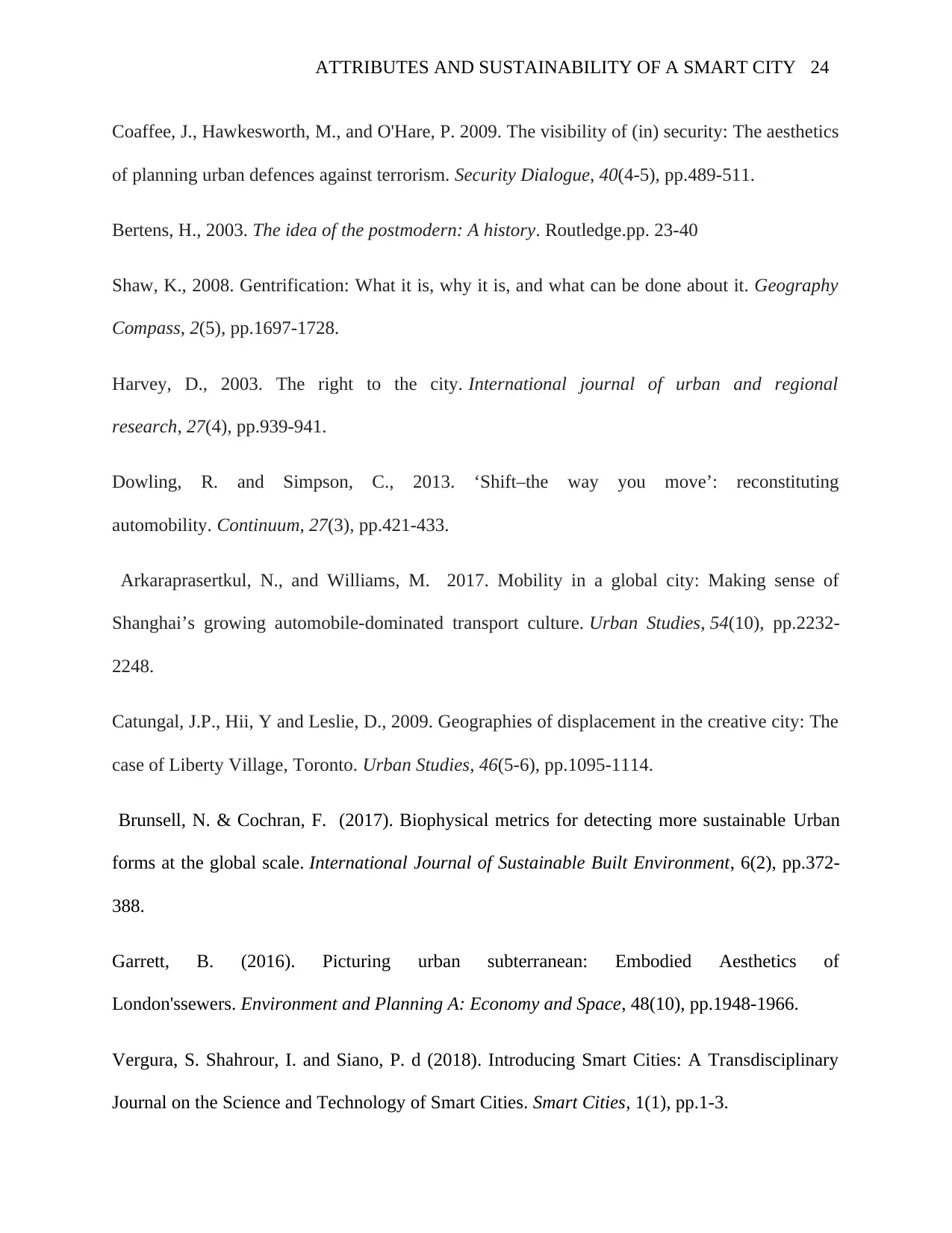
ATTRIBUTES AND SUSTAINABILITY OF A SMART CITY 24
Coaffee, J., Hawkesworth, M., and O'Hare, P. 2009. The visibility of (in) security: The aesthetics
of planning urban defences against terrorism. Security Dialogue, 40(4-5), pp.489-511.
Bertens, H., 2003. The idea of the postmodern: A history. Routledge.pp. 23-40
Shaw, K., 2008. Gentrification: What it is, why it is, and what can be done about it. Geography
Compass, 2(5), pp.1697-1728.
Harvey, D., 2003. The right to the city. International journal of urban and regional
research, 27(4), pp.939-941.
Dowling, R. and Simpson, C., 2013. ‘Shift–the way you move’: reconstituting
automobility. Continuum, 27(3), pp.421-433.
Arkaraprasertkul, N., and Williams, M. 2017. Mobility in a global city: Making sense of
Shanghai’s growing automobile-dominated transport culture. Urban Studies, 54(10), pp.2232-
2248.
Catungal, J.P., Hii, Y and Leslie, D., 2009. Geographies of displacement in the creative city: The
case of Liberty Village, Toronto. Urban Studies, 46(5-6), pp.1095-1114.
Brunsell, N. & Cochran, F. (2017). Biophysical metrics for detecting more sustainable Urban
forms at the global scale. International Journal of Sustainable Built Environment, 6(2), pp.372-
388.
Garrett, B. (2016). Picturing urban subterranean: Embodied Aesthetics of
London'ssewers. Environment and Planning A: Economy and Space, 48(10), pp.1948-1966.
Vergura, S. Shahrour, I. and Siano, P. d (2018). Introducing Smart Cities: A Transdisciplinary
Journal on the Science and Technology of Smart Cities. Smart Cities, 1(1), pp.1-3.
Coaffee, J., Hawkesworth, M., and O'Hare, P. 2009. The visibility of (in) security: The aesthetics
of planning urban defences against terrorism. Security Dialogue, 40(4-5), pp.489-511.
Bertens, H., 2003. The idea of the postmodern: A history. Routledge.pp. 23-40
Shaw, K., 2008. Gentrification: What it is, why it is, and what can be done about it. Geography
Compass, 2(5), pp.1697-1728.
Harvey, D., 2003. The right to the city. International journal of urban and regional
research, 27(4), pp.939-941.
Dowling, R. and Simpson, C., 2013. ‘Shift–the way you move’: reconstituting
automobility. Continuum, 27(3), pp.421-433.
Arkaraprasertkul, N., and Williams, M. 2017. Mobility in a global city: Making sense of
Shanghai’s growing automobile-dominated transport culture. Urban Studies, 54(10), pp.2232-
2248.
Catungal, J.P., Hii, Y and Leslie, D., 2009. Geographies of displacement in the creative city: The
case of Liberty Village, Toronto. Urban Studies, 46(5-6), pp.1095-1114.
Brunsell, N. & Cochran, F. (2017). Biophysical metrics for detecting more sustainable Urban
forms at the global scale. International Journal of Sustainable Built Environment, 6(2), pp.372-
388.
Garrett, B. (2016). Picturing urban subterranean: Embodied Aesthetics of
London'ssewers. Environment and Planning A: Economy and Space, 48(10), pp.1948-1966.
Vergura, S. Shahrour, I. and Siano, P. d (2018). Introducing Smart Cities: A Transdisciplinary
Journal on the Science and Technology of Smart Cities. Smart Cities, 1(1), pp.1-3.
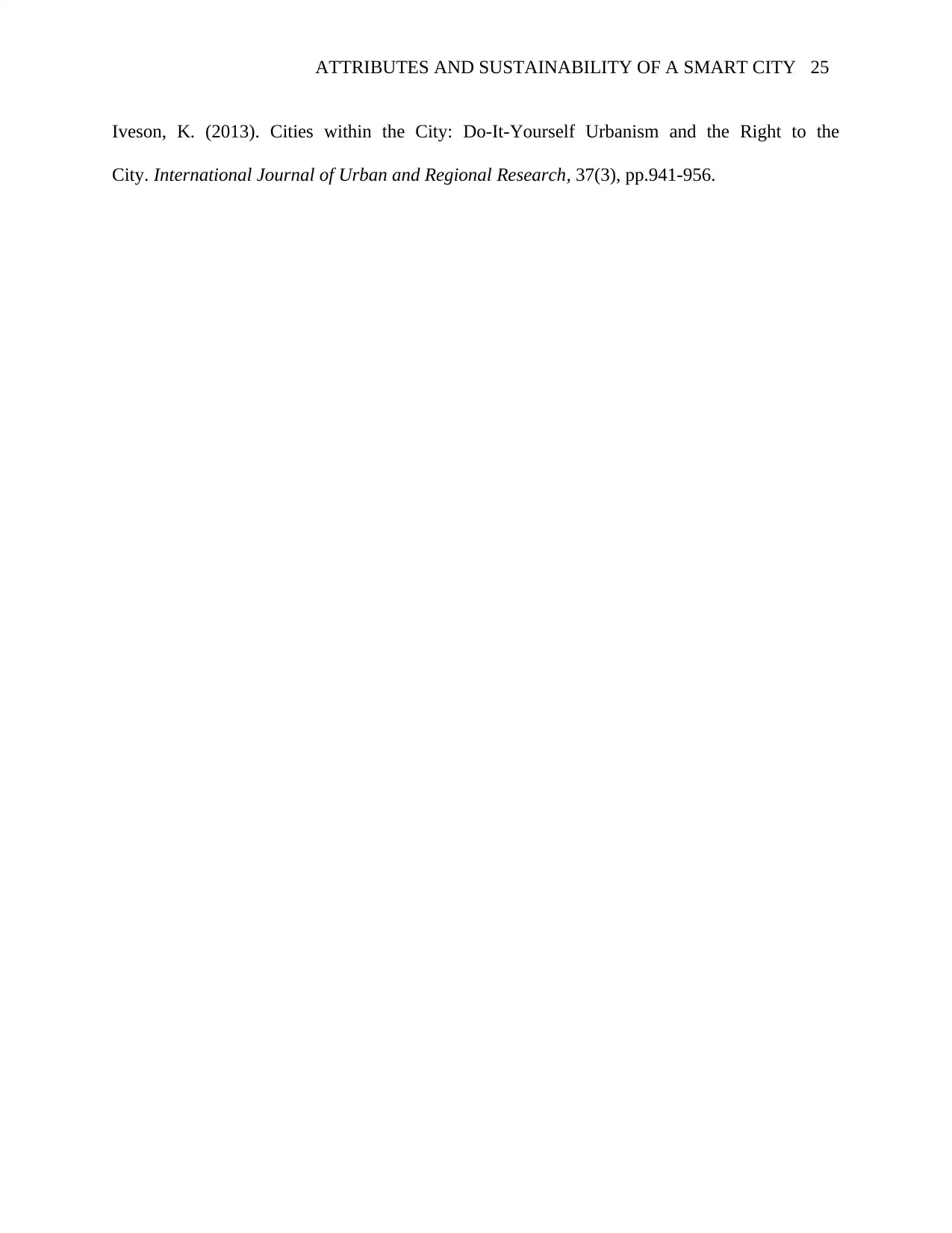
ATTRIBUTES AND SUSTAINABILITY OF A SMART CITY 25
Iveson, K. (2013). Cities within the City: Do-It-Yourself Urbanism and the Right to the
City. International Journal of Urban and Regional Research, 37(3), pp.941-956.
Iveson, K. (2013). Cities within the City: Do-It-Yourself Urbanism and the Right to the
City. International Journal of Urban and Regional Research, 37(3), pp.941-956.
1 out of 25
Related Documents
Your All-in-One AI-Powered Toolkit for Academic Success.
+13062052269
info@desklib.com
Available 24*7 on WhatsApp / Email
![[object Object]](/_next/static/media/star-bottom.7253800d.svg)
Unlock your academic potential
© 2024 | Zucol Services PVT LTD | All rights reserved.




